Unit 3: Early Europe and Colonial Americas, 200–1750 CE
Key Events of Early Europe and the Americas Art
Edict of Milan and the "Peace of the Church"
Edict of Milan:
Issued in 313 AD by Roman Emperor Constantine
Granted religious tolerance to Christians in the Roman Empire
Ended the persecution of Christians and allowed them to practice their faith freely
"Peace of the Church":
Established in 380 AD by Roman Emperor Theodosius
Made Christianity the official religion of the Roman Empire
Prohibited the practice of pagan religions and heresies
Strengthened the power of the Christian Church in the Empire
Formation of the Byzantine Empire
The Byzantine Empire was formed in 324 AD by Emperor Constantine I.
It was originally known as the Eastern Roman Empire.
The capital was Constantinople, which was strategically located for trade and defense.
The Byzantine Empire was a continuation of the Roman Empire, but with Greek as the official language and Christianity as the dominant religion.
The Byzantine Empire lasted for over 1000 years, until it fell to the Ottoman Turks in 1453.
Iconoclastic Controversy
A dispute over the use of religious images (icons) in the Byzantine Empire
Began in 726 AD under Emperor Leo III
Iconoclasts believed that the use of icons was idolatry and violated the Ten Commandments
Iconodules believed that icons were necessary for religious worship and veneration
The controversy led to the destruction of many religious images and the persecution of iconodules
The controversy was resolved in 843 AD with the restoration of the use of icons in the Byzantine Empire
Spread of Islam into al-Andalus
Muslims conquered al-Andalus in 711 AD
Tariq ibn Ziyad led the Muslim army
Abd al-Rahman I established the Umayyad Emirate of Cordoba in 756 AD
Cordoba became a center of Islamic learning and culture
The Alhambra palace was built in Granada in the 14th century
The Reconquista ended Muslim rule in al-Andalus in 1492 AD
Hundred Years' War
The Hundred Years' War was a series of conflicts between England and France from 1337 to 1453.
It was fought over territorial disputes and the English claim to the French throne.
The war saw major battles such as Crecy, Poitiers, and Agincourt. It ended with the French victory and the expulsion of the English from France, except for the port of Calais.
Black Death of 1348
The Black Death was a deadly pandemic in the mid-14th century
It originated in China or Central Asia and spread to Europe through trade routes
It was caused by the bacterium Yersinia pestis
It was transmitted to humans through fleas that infested rats
Symptoms included fever, chills, vomiting, and painful buboes
The mortality rate was extremely high, with estimates suggesting up to 50% of the European population died
The Black Death caused economic, social, and political upheaval
It led to increased wages for workers and a decline in feudal lord power
It also led to a rise in anti-Semitism
The pandemic inspired works of art and literature reflecting its trauma and suffering.
Italian and Northern Renaissance
The Italian Renaissance was a cultural and artistic movement that began in Italy in the 14th century and lasted until the 17th century. It was characterized by a renewed interest in classical antiquity, humanism, and the arts.
The Northern Renaissance, which took place in Northern Europe, was influenced by the Italian Renaissance but had its own distinct characteristics, such as a focus on religious themes and a greater emphasis on realism in art.
Protestant Reformation
The Protestant Reformation was a religious movement in the 16th century that aimed to reform the Catholic Church.
It was led by figures such as Martin Luther, John Calvin, and Huldrych Zwingli, who challenged the authority of the Pope and emphasized the importance of individual faith and the Bible.
The movement resulted in the establishment of Protestant denominations such as Lutheranism, Calvinism, and Anglicanism, and had a significant impact on European history and culture.
Spanish Conquest of the Americas
The Spanish Conquest of the Americas refers to the period of European colonization and exploration of the Americas by the Spanish Empire.
It began in the late 15th century with the arrival of Christopher Columbus in the Caribbean and continued throughout the 16th and 17th centuries.
The Spanish established colonies in present-day Mexico, Central America, South America, and the Caribbean, and brought about significant changes to the indigenous cultures and societies of the region.
The conquest had a profound impact on the history and development of the Americas.
Artistic Movements of Early Europe and the Americas Art
Late Antique Art
Materials/Techniques/Processes
Mosaic: small pieces of colored glass, stone, or ceramic set in mortar
Ivory: carved from elephant tusks
Metalwork: gold, silver, bronze, and copper
Manuscripts: parchment or vellum, ink, and pigments
Purpose
Religious devotion: many works were created for use in churches and other religious settings
Imperial propaganda: some works were commissioned by rulers to promote their power and authority
Personal piety: some works were created by individuals for their own spiritual benefit
Audiences
Churchgoers: many works were intended for use in religious services and would have been seen by congregations
Rulers and elites: some works were commissioned by rulers and other wealthy patrons
Private individuals: some works were created by individuals for their own use or enjoyment.
Byzantine Art
Materials/Techniques/Processes:
Mosaic: tesserae arranged to create an image
Fresco: pigments applied to wet plaster, which dries to create a durable surface
Encaustic: pigments mixed with hot wax, which is then applied to a surface and fused with heat
Icon: painted with egg tempera, a mixture of egg yolk and pigments
Audiences:
Religious communities: Byzantine art was primarily created for use in churches and other religious spaces
Wealthy patrons: some wealthy individuals commissioned Byzantine art for their private chapels or homes
Purpose:
Religious devotion: Was intended to inspire religious devotion and aid in worship
Political propaganda: Some Byzantine art was created to promote the power and authority of the emperor or other rulers
Education: some Byzantine art was used to teach religious stories and concepts to illiterate audiences.
Islamic Art
Materials:
Calligraphy: Writing in Arabic script using ink and paper
Ceramics: Pottery decorated with intricate designs and patterns
Textiles: Woven fabrics with geometric or floral motifs
Metalwork: Decorative objects made of gold, silver, or bronze
Carpets: Hand-woven rugs with intricate designs
Techniques/Processes:
Geometric patterns: Using mathematical principles to create intricate designs
Arabesque: Interlacing floral and plant motifs to create a continuous pattern
Illumination: Decorating manuscripts with gold leaf and bright colors
Mosaic: Creating images by arranging small pieces of colored glass or stone
Miniature painting: Creating detailed paintings on small surfaces
Audiences:
Religious leaders: Islamic art was often commissioned by religious leaders to decorate mosques and other religious buildings
Wealthy patrons: Wealthy individuals would commission artists to create decorative objects for their homes
Common people: Islamic art was also created for everyday use, such as textiles and ceramics
Purpose:
Religious devotion: Islamic art often served a religious purpose, such as decorating mosques and illustrating religious texts
Cultural expression: Islamic art was a way for artists to express their cultural identity and showcase their skills
Status symbol: Wealthy patrons would commission elaborate works of art to display their wealth and status.
Early Medieval Art
Materials:
Parchment or vellum for manuscripts
Stone and metal for sculpture
Wood for architectural elements and small-scale sculpture
Pigments and gold leaf for illuminated manuscripts
Techniques/Processes:
Manuscript illumination
Cloisonné and champlevé enamelwork
Stone carving and metalworking
Animal style and interlace decoration
Fresco and tempera painting
Purpose:
Religious devotion and instruction
Commemoration of rulers and important figures
Decoration of churches and other religious buildings
Display of wealth and power
Audiences:
Members of the clergy and religious orders
Wealthy patrons and rulers
Illiterate or semi-literate laypeople who could understand visual images better than written texts
Romanesque Art
Materials:
Stone: Used for sculptural works such as portals, capitals, and reliefs.
Wood: Used for sculptures, altarpieces, and choir stalls.
Bronze: Used for casting sculptures and decorative elements.
Ivory: Used for carving small sculptures and decorative objects.
Manuscripts: Used for illuminated manuscripts, which were highly valued for their intricate illustrations and calligraphy.
Stained glass: Used for windows, which were often used to tell religious stories and convey moral messages.
Frescoes: Used for painting murals on walls and ceilings.
Tapestries: Used for weaving large-scale decorative textiles.
Techniques/Processes:
Sculpture: Carving, casting, and modeling in stone, wood, bronze, and ivory.
Painting: Using pigments to create images on various surfaces such as wood, canvas, and walls.
Metalworking: Casting and forging metal objects such as chandeliers, candlesticks, and reliquaries.
Manuscript illumination: Decorating manuscripts with intricate illustrations and calligraphy.
Mosaic: Creating images by arranging small pieces of colored glass or stone.
Stained glass: Creating images by arranging colored glass pieces in lead frames.
Fresco painting: Painting on wet plaster to create a durable and long-lasting image.
Tapestry weaving: Weaving large-scale decorative textiles with intricate designs.
Audiences:
Churchgoers: Romanesque art was primarily created for use in churches and cathedrals, and was intended to inspire devotion and awe in those who attended religious services.
Pilgrims: Many Romanesque churches were pilgrimage sites, and the art within them was intended to inspire and guide pilgrims on their spiritual journeys.
Monks and nuns: Many monasteries and convents commissioned Romanesque art for use in their chapels and other religious spaces.
Royalty and nobility: Wealthy patrons, including kings and queens, commissioned Romanesque art for their private chapels and as gifts to churches and monasteries.
Wealthy merchants: Some wealthy merchants also commissioned Romanesque art for their private chapels and homes.
Purpose:
To glorify God and the Church: Romanesque art was created to honor and celebrate the Christian faith and the power of the Church.
To educate the illiterate masses about religious stories and beliefs: Many people in the Middle Ages were illiterate, so art was used as a way to convey
Gothic Art
Techniques/Processes
Ribbed vaults: A vault with a framework of ribs or arches under the intersections of the vaulted sections.
Flying buttresses: An arched stone support that extends from the upper portion of a wall to a pier of great mass.
Pointed arches: An arch with a pointed crown, characteristic of Gothic architecture.
S-curve (ogee) shape: A double curve, shaped like an S, used in architecture and decoration.
Elaborate tracery: Decorative stone openwork, typically in the upper part of a Gothic window.
Gargoyles and grotesques: A carved or sculpted figure, typically with a spout designed to convey water from a roof and away from the side of a building.
Illuminated manuscripts: A manuscript in which the text is supplemented with such decoration as initials, borders, and miniature illustrations.
Polychrome sculpture: A sculpture decorated in several colors.
Audiences
The Church
Wealthy patrons
The general public
Purpose
To glorify God and the Church
To inspire awe and devotion in the viewer
To showcase the wealth and power of the Church and its patrons
To educate the illiterate masses about religious stories and figures.
Renaissance Art
Materials:
Oil paint: A type of paint made by mixing pigments with oil, usually linseed oil. It is known for its slow drying time and ability to create rich, layered colors.
Canvas: A type of fabric used as a surface for painting. It is typically made from cotton or linen and stretched over a wooden frame.
Wood panels: A flat surface made of wood that was commonly used for painting before the introduction of canvas. It was often prepared with a layer of gesso before painting.
Fresco: A painting technique in which pigments are applied to wet plaster. This allows the colors to become embedded in the wall and creates a durable, long-lasting artwork.
Techniques/Processes:
Linear perspective: A technique used in art to create the illusion of depth and space on a flat surface by using converging lines that meet at a vanishing point.
Chiaroscuro: An Italian term that refers to the use of strong contrasts between light and dark in art to create a sense of volume and three-dimensionality.
Sfumato: An Italian term that refers to a painting technique used to create a soft, hazy effect by blending colors or tones together to create a gradual transition from light to dark.
Foreshortening: A technique used in art to create the illusion of depth and perspective by shortening the length of an object as it recedes into the distance.
Glazing: A painting technique that involves applying thin, transparent layers of paint over a previously painted surface to create depth, luminosity, and color harmony.
Audiences:
Wealthy patrons
The Church
The general public
Purpose:
To glorify God and the Church
To celebrate humanism and individualism
To showcase technical skill and artistic innovation
To commemorate historical events and figures
Baroque Art
Materials:
Oil paint
Canvas
Marble
Gilt bronze
Ivory
Tortoiseshell
Mother-of-pearl
Precious stones
Techniques/Processes:
Chiaroscuro (use of light and shadow)
Tenebrism (dramatic use of light and dark)
Illusionistic ceiling painting (fresco)
Trompe l'oeil (trick of the eye)
Contrapposto (pose of figures)
Ornate decoration and embellishment
Audience:
Wealthy patrons
The Catholic Church
Royalty and nobility
Aristocracy
Purpose:
To glorify the Catholic Church and its teachings
To demonstrate the power and wealth of patrons
To evoke emotion and awe in viewers
Early Europe and Colonial America Artworks
➼ Catacomb of Priscilla
Details
Late Antique Europe
200–400
Excavated tufa and fresco
Found in Rome, Italy
Form and Function
Catacombs are passageways beneath Rome that extend for about 100 miles and contain the tombs of 4 million dead.
They contain the tombs of seven popes and many early Christian martyrs.
The Priscilla catacomb has some 40,000 burials.
Context
Called Priscilla because she was the donor of the land for her family’s burial. It was then opened up to Christians.
Greek Chapel
Named for two Greek inscriptions painted on the right niche.
Three niches for sarcophagi.
Lower portions done in the first Pompeian style of painting with imitation marble paneling enriching the surface.
Upper portions decorated with paintings in later Pompeian styles: sketchy painterly brushstrokes.
Contains scenes of Old and New Testament stories.
Old Testament scenes show martyrs sacrificing for their faith.
New Testament scenes show miracles of Jesus.
Orant fresco
Fresco over a tomb niche set over an arched wall; cemetery of a family vault.
Central figure stands with arms outstretched in prayer; perhaps the same woman seen three times.
Figure is compact, dark, and set off from a light background with terse angular contours and emphatic gestures.
Figure prays for salvation in heaven.
Deeply set eyes—windows to the soul—staring upward implore God’s deliverance.
Left: painting of a teacher with children, or the image of a couple being married with a bishop.
At the right, mother and child, perhaps Mary with Christ or the Church.
Good Shepherd fresco
Early Christian art often shows parallels between Old and New Testament stories, which Christians see as a fulfillment of the Hebrew scriptures and shows their interest in adapting them to their own context.
Restrained portrait of Christ as a Good Shepherd, a pastoral motif in ancient art going back to the Greeks.
Symbolism of the Good Shepherd: rescues individual sinners in his flock who stray.
Stories of the life of the Old Testament Prophet Jonah often appear in the lunettes; Jonah’s regurgitation from the mouth of a big fish is seen as prefiguring Christ’s resurrection.
Peacocks in lunettes symbolize eternal life; quails symbolize earthly life; Christ is seen as a bridge between these worlds.

➼ Santa Sabina
Detail
Late Antique Europe
422–432
Made of brick, stone, and wooden roof
Found in Rome, Italy
Form
Three-aisled basilica culminating in an apse; no transept.
Long, tall, broad nave; axial plan.
Axial Plan: a church with a long nave whose focus is the apse; so-called because it is designed along an axis
Windows not made of glass, but selenite, a type of transparent and colorless gypsum.
Flat wooden roof; coffered ceiling; thin walls support a light roof.
Function
Early Christian parish church.
As in the Jewish tradition, men and women stood separately; the men stood in the main aisle, the women in the side aisles with a partial view.
Context
Spolia: tall slender columns taken from the Temple of Juno in Rome, erected on this site; a statement about the triumph of Christianity over paganism.
Bare exterior, sensitively decorated interior—represents the Christian whose exterior may be gross, but whose interior soul is beautiful.
Built by Peter of Illyria.
Patronage: According to an inscription in the narthex, the basilica was founded by Pope Celestine I (422–432).
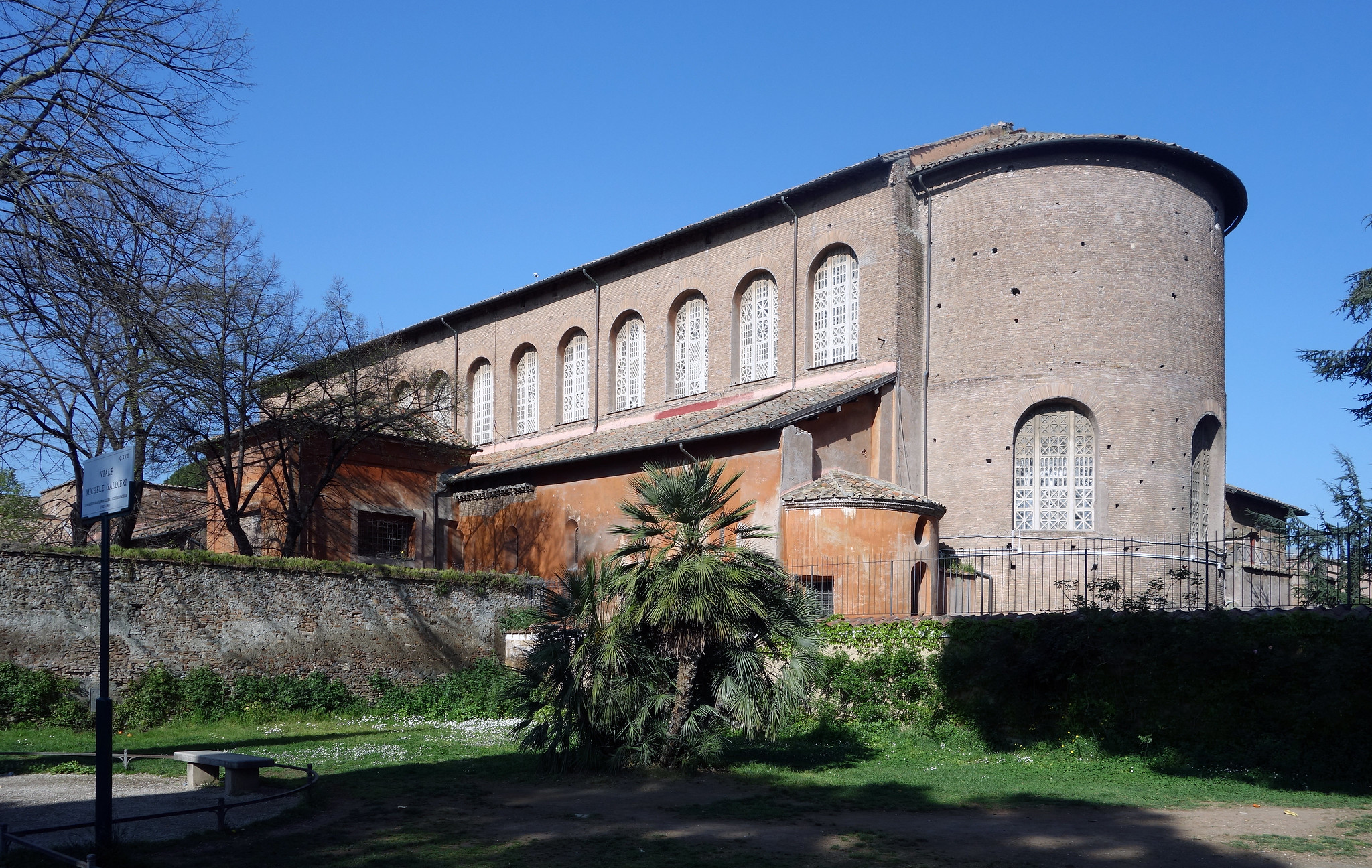
➼ Hagia Sophia
Details
By Anthemius of Tralles and Isidorus of Miletus,
532–537
Made of brick and ceramic elements, with stone and mosaic veneer,
Found in Constantinople (Istanbul)
Form Exterior: plain and massive with little decoration.
Form Interior:
Combination of centrally and axially planned church.
Arcade decoration: walls and capitals are flat and thin and richly ornamented.
Capitals diminish classical allusions; surfaces contain deeply cut acanthus leaves.
Cornice unifies space.
Large fields for mosaic decoration; at one time there were four acres of gold mosaics on the walls. –Many windows punctuate wall spaces.
Dome: the first building to have a dome supported by pendentives.
Altar at end of nave, but the emphasis placed over the area covered by the dome.
Large central dome, with 40 windows at base symbolically acting as a halo over the congregation when filled with light.
Function
Originally a Christian church; Hagia Sophia means “holy wisdom.”
Built on the site of another church that was destroyed during the Nike Revolt in 532.
Converted to a mosque in the fifteenth century; minarets added in the Islamic period.
Converted into a museum in 1935; reconverted into a mosque in 2020.
Context
Marble columns appropriated from Rome, Ephesus, and other Greek sites.
Patrons were Emperor Justinian and Empress Theodora, who commissioned the work after the burning of the original building in the Nike Revolt.
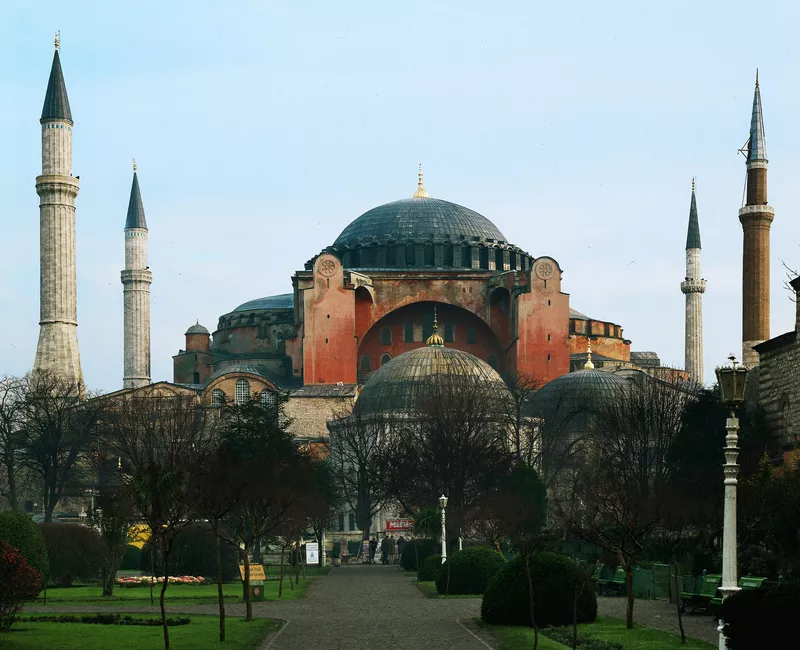
➼ San Vitale
Details
Early Byzantine Europe
526–547
Made of brick, marble, and stone veneer
Found in Ravenna, Italy
Form
Eight-sided church.
Plain exterior; porch added later, in the Renaissance.
Large windows for illuminating interior designs.
Interior has thin columns and open arched spaces.
Dematerialization of the mass of the structure.
Combination of axial and central plans.
Spolia: bricks taken from ruined Roman buildings reused here.
Martyrium design: circular plan in an octagonal format.
Function: Christian church.
Context
Mysterious space symbolically connects with the mystic elements of religion.
Banker Julianus Argentarius financed the building of San Vitale.
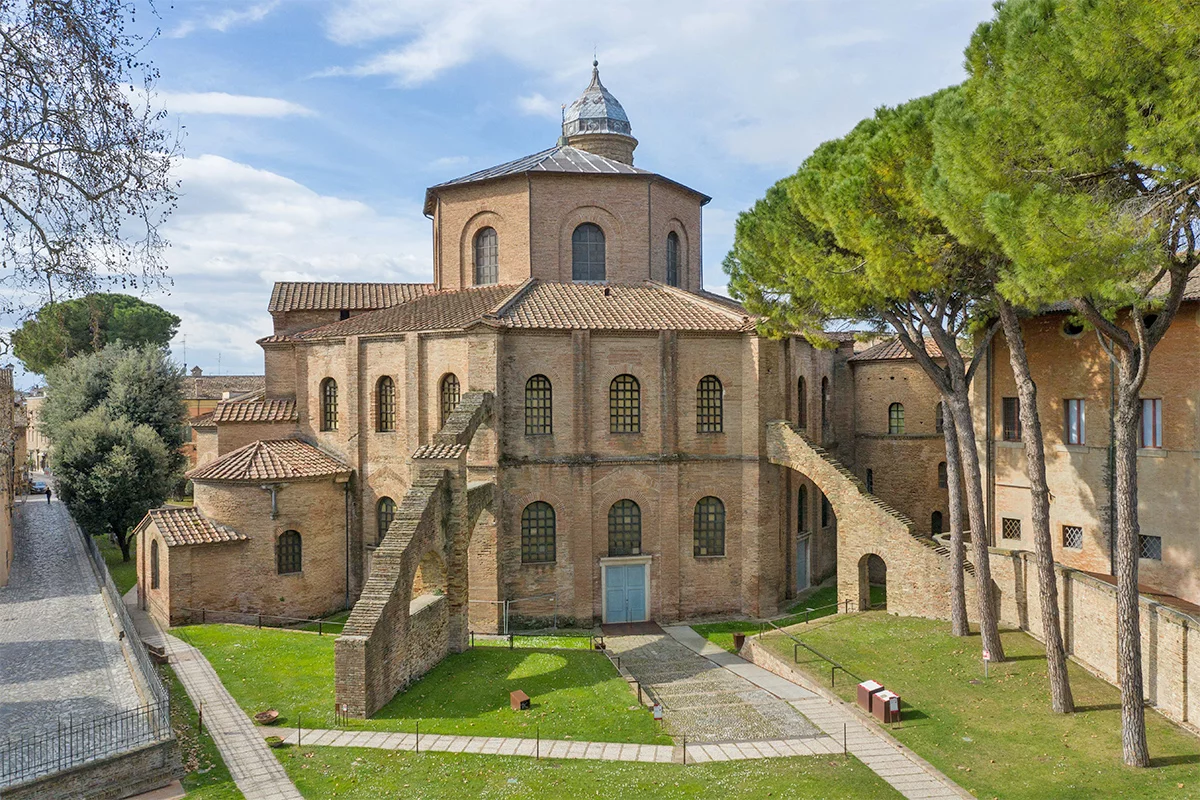
➼ Justinian Panel
Details
c. 547
A mosaic
From San Vitale, Ravenna
Content
Emperor Justinian, as the central image, dominates all; emperor’s rank indicated by his centrality, halo, fibula, and crown.
To his left the clergy, to his right the military.
Dressed in royal purple and gold.
Divine authority symbolized by the halo; Justinian is establishing religious and political control over Ravenna.
Form
Symmetry, frontality.
Slight impression of procession forward.
Figures have no volume; they seem to float and yet step on each other’s feet.
Minimal background: green base at feet; golden background indicates timelessness.
Function
Justinian holds a paten, or plate, for the Eucharist; participating in the service of the Mass almost as if he were a celebrant—his position over the altar enhances this reference.
Justinian appears as head of church and state; regent of Christ on earth.
Context
Archbishop Maximianus is identified; he is the patron of San Vitale.
XP or Chi Rho, the monogram of Christ, on soldier’s shield shows them as defenders of the faith, or Christ’s soldiers on earth.
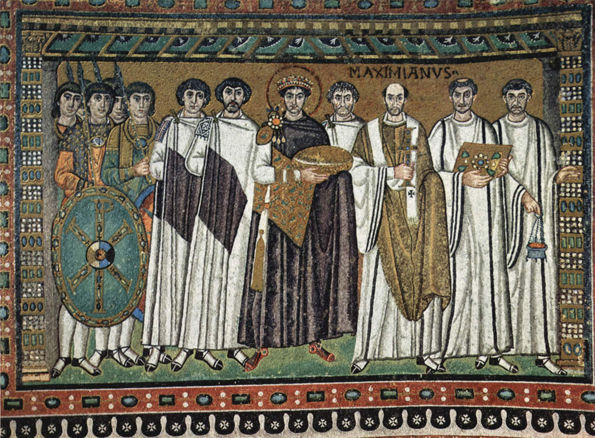
➼ Theodora Panel
Details
c. 547
A mosaic
From San Vitale, Ravenna
Content
Empress Theodora stands in an architectural framework holding a chalice for the Mass and is about to go behind the curtain.
Form
Slight displacement of absolute symmetry with Empress Theodora; she plays a secondary role to her husband.
She is simultaneously frontal and moving to our left.
Figures are flattened and weightless; barely a hint of a body can be detected beneath the drapery.
Function
She holds a chalice for the wine; participating in the service of the Mass almost as if she were a celebrant.
She is juxtaposed with Emperor Justinian on the flanking wall; both figures hold the sacred items for the Mass.
Context
Richly robed empress and ladies at court.
The three Magi, who bring gifts to the baby Jesus, are depicted on the hem of her dress.
This reference draws parallels between Theodora and the Magi.

➼ Vienna Genesis
Details
Early Byzantine Europe
Early 6th century
An illuminated manuscript, tempera, gold, and silver on purple vellum, Austrian National Library, Vienna
Form
Lively, softly modeled figures.
Classical training of the artists: contrapposto, foreshortening, shadowing, perspective, classical allusions.
Shallow settings.
Fluid movement of decorative figures.
Richly colored and shaded.
Two rows linked by a bridge or a pathway.
Text placed above illustrations, which are on the lower half of the page.
Continuous narrative.
Context
First surviving illustrations of the stories from Genesis.
Genesis stories are done in continuous narrative with genre details.
Written in Greek.
Partial manuscript: 48 of 192 (?) illustrations survive.
Materials and Origin
Manuscript painted on vellum.
Written in silver script, now oxidized and turned black.
Origin uncertain: a scriptorium in Constantinople? Antioch?
Perhaps done in a royal workshop; purple parchment is a hallmark of a royal institution.
Rebecca and Eliezer at the Well
Genesis 24: 15–61.
Rebecca, shown twice, emerges from the city of Nahor with a jar on her shoulder to go down to the spring.
She quenches the thirst of a camel driver, Eliezer, and his camels.
Colonnaded road leads to the spring.
Roman water goddess personifies the spring.
Jacob Wrestling the Angel
Genesis 32: 22–31.
Jacob takes his two wives, two maids, and eleven children and crosses a river; the number of children is abbreviated.
At night Jacob wrestles an angel.
The angel strikes Jacob on the hip socket.
Classical influence in the Roman-designed bridge, but medieval influence in the bridge’s perspective: i.e., the shorter columns are placed in the nearer side of the bridge and the taller columns behind the figures.
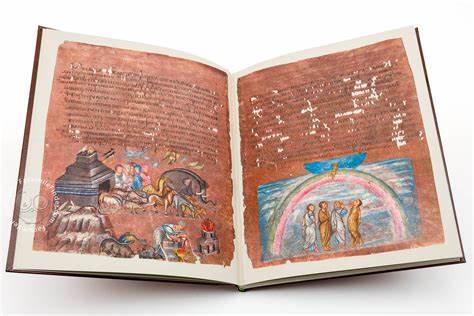
➼ Virgin (Theotokos) and Child between Saints Theodore and George
Details
Early Byzantine Europe
6th or early 7th centuries
Encaustic on wood
Found in Monastery of Saint Catherine, Mount Sinai, Egypt
Function
Icon placed in a medieval monastery for devotional purposes.
Content and Form
Virgin and Child centrally placed; firmly modeled.
Mary as Theotokos, mother of God.
Mary looks beyond the viewer as if seeing into the future.
Christ child looks away, perhaps anticipating his crucifixion.
Saints Theodore and George flank Virgin and Child.
Warrior saints.
Stiff and hieratic.
Directly stare at the viewer; engage the viewer directly.
Angels in background look toward heaven.
Painted in a classical style with brisk brushwork in encaustic, a Roman tradition.
Turned toward the descending hand of God, which comes down to bless the scene.
Because the three groups are in very different styles, it has been assumed that they were painted by three different artists.
Context
Pre–Iconoclastic Controversy icon, located in the Sinai and encaustic places it near Roman-Egyptian encaustic painted portraits.
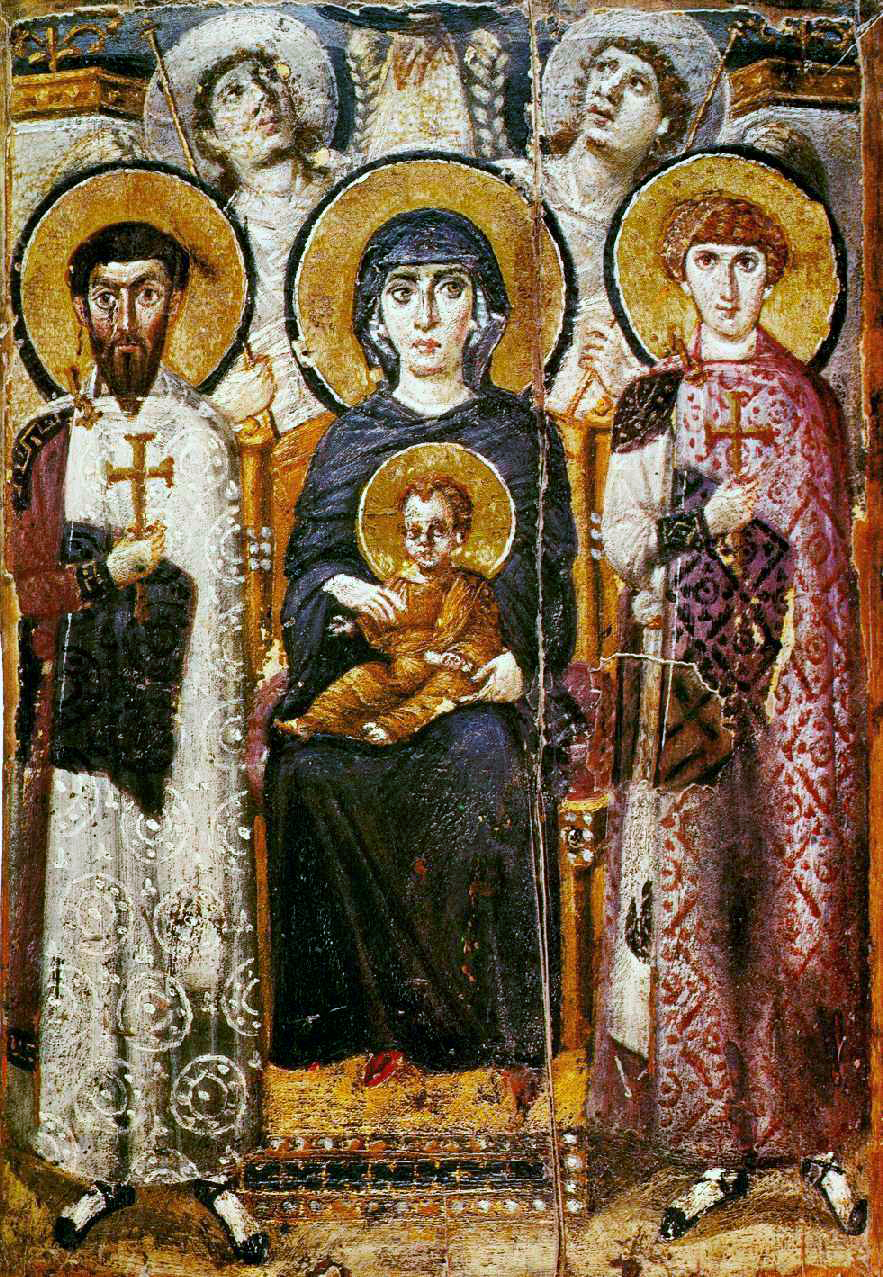
➼ Merovingian looped fibulae
Details
Early medieval Europe
Mid-6th century
Made of silver gilt worked in filigree with semiprecious stones, inlays of garnets and other stones
Found in Musee d’Archeologie Nationale, Saint-Germain-en-Laye, France
Form
Zoomorphic elements—fish and bird, possibly Christian or pagan symbols.
Highly abstracted forms derived from the classical tradition.
Function
Fibula: a pin or brooch used to fasten garments; showed the prestige of the wearer.
Small portable objects.
Context
Found in a grave.
Probably made for a woman.
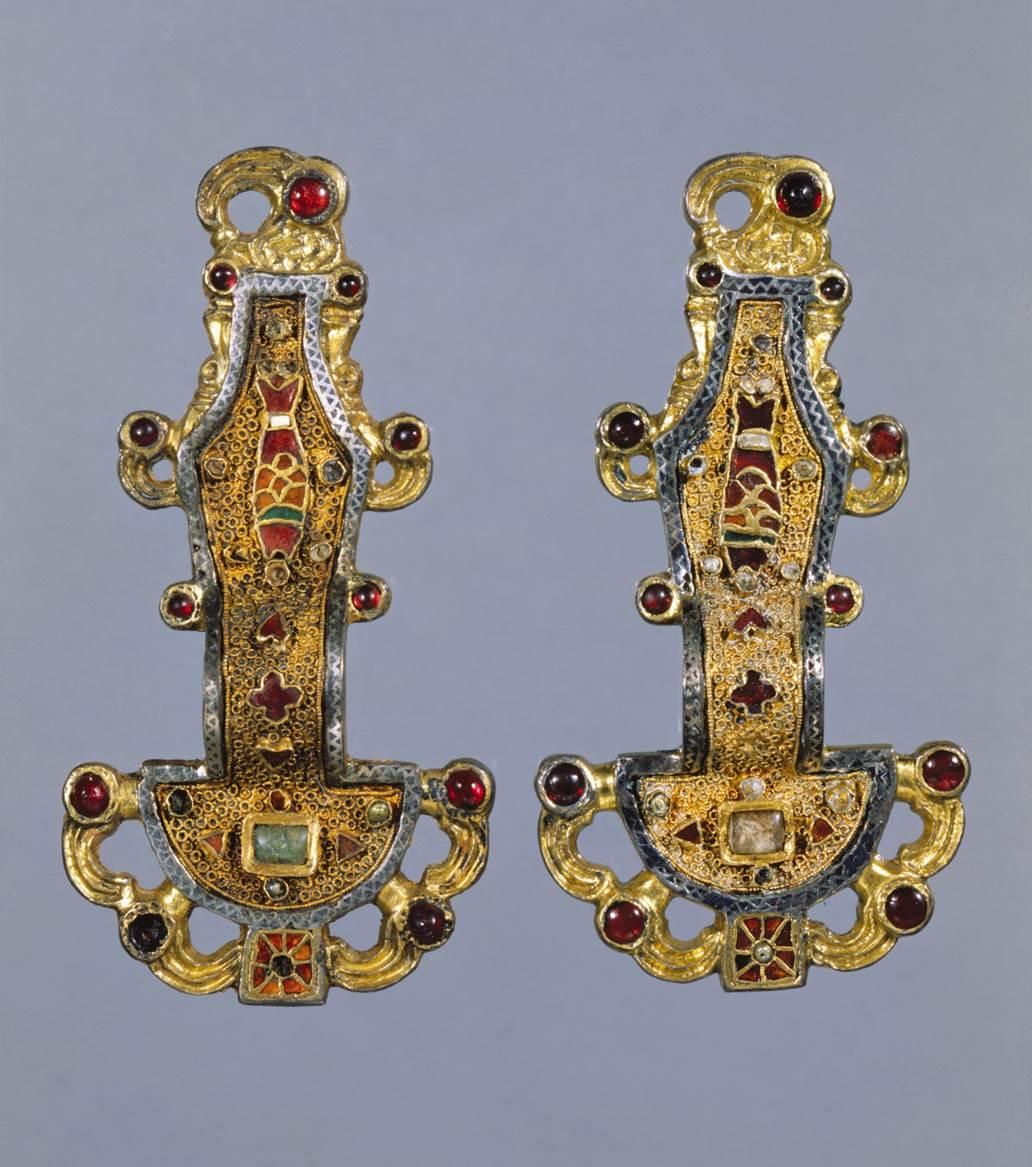
➼ Lindisfarne Gospels
Details
Early medieval Europe
c. 700
Made of illuminated manuscript, ink, pigments, and gold on vellum
Found in British Library, London
Gospels: the first four books of the New Testament that chronicle the life of Jesus Christ
Function
The first four books of the New Testament
Used for services and private devotion.
Materials: Manuscript made from 130 calfskins.
Content
Evangelist portraits come first, followed by a carpet page.
These pages are followed by the opening of the gospel with a large series of capital letters.
Context
Written by Eadrith, bishop of Lindisfarne.
Unusual in that it is the work of an individual artist and not a team of scribes.
Written in Latin with annotations in English between the lines; some Greek letters
Latin script is called half-uncial.
English added around 970; it is the oldest surviving manuscript of the Bible in English.
English script called Anglo-Saxon minuscule.
Uses Saint Jerome’s translation of the Bible, called the Vulgate.
Colophon at end of the book discusses the making of the manuscript.
Colophon: a commentary on the end panel of a Chinese scroll; an inscription at the end of a manuscript containing relevant information on its publication
Made and used at the Lindisfarne Priory on Holy Island, a major religious center that housed the remains of Saint Cuthbert.
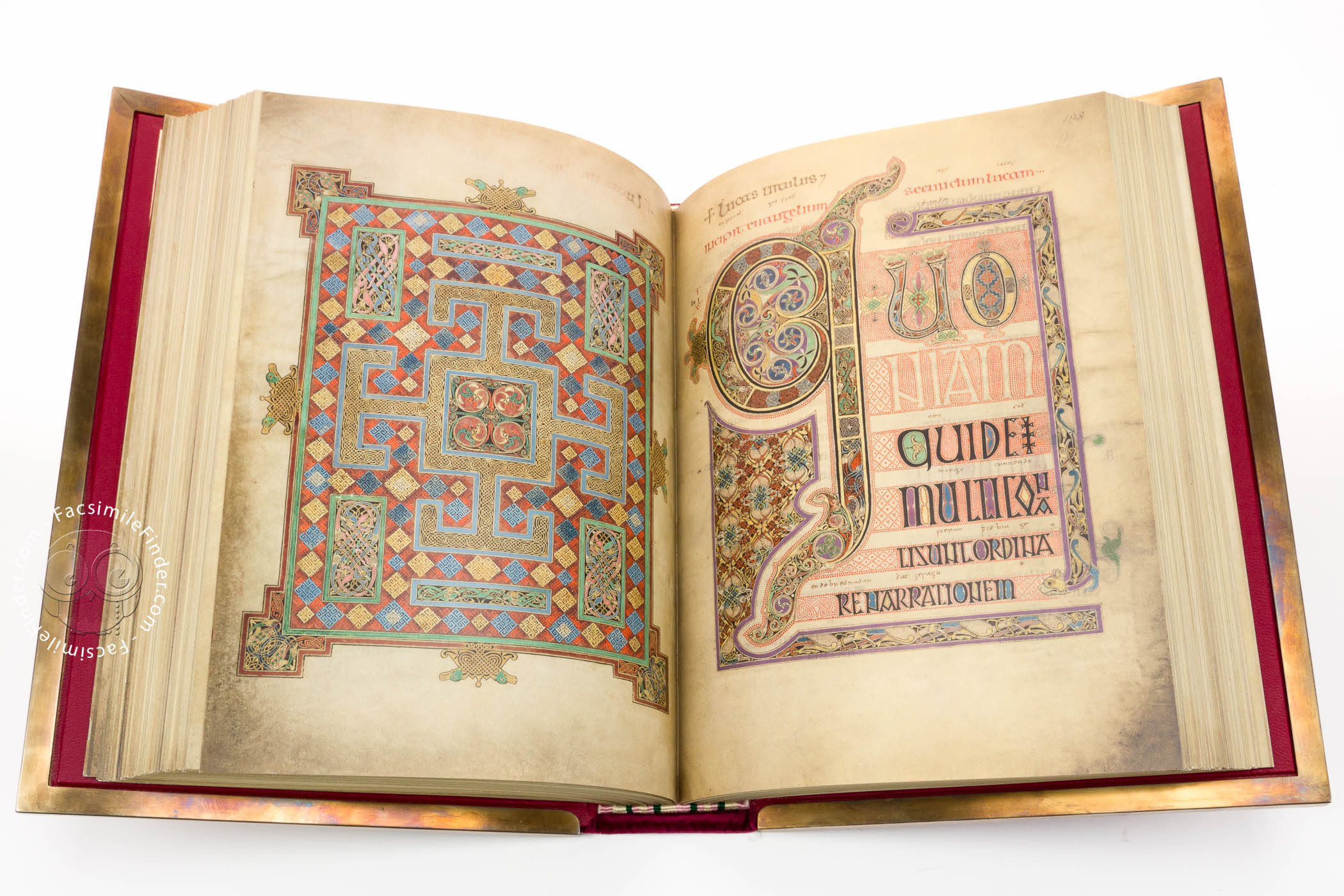
➼ Church of Sainte-Foy
Details
Romanesque Europe
c. 1050–1130, stone
Conques, France
Form
Church built to handle the large number of pilgrims: wide transepts, large ambulatory with radiating chapels.
Radiating chapel: a chapel that extends out in a radial pattern from an apse or an ambulatory
Transept: an aisle in a church perpendicular to the nave
Massive heavy interior walls, unadorned.
No clerestory; light provided by windows over the side aisles and galleries.
Barrel vaults in nave, reinforced by transverse arches.
Transverse arch: an arch that spans an interior space connecting opposite walls by crossing from side to side
Cross-like ground plan, called a Latin cross.
Function
Christian church built along the pilgrimage road to Santiago de Compostela, a popular pilgrimage center for the worship of the relics of Saint James.
Radiating chapels housed relics of the saints.
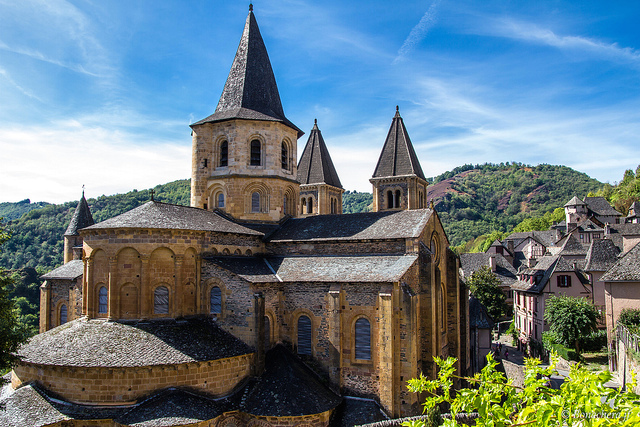
➼ Last Judgment
Details
1050–1130
Made of stone and paint
Found in Sainte-Foy, Conques
Form
Largest Romanesque tympanum.
124 figures densely packed together; originally richly painted.
Function
Last Judgment cautions pilgrims that life is transitory and one should prepare for the next life.
Subject of the tympanum reminds pilgrims of the point of their pilgrimage.
Content
Christ, as a strict judge, divides the world into those going to heaven and those going to hell.
Christ is depicted with a welcoming right hand, a cast down left hand.
Christ sits in a mandorla.
A dividing line runs vertically through the cross in the middle of the composition.
The Archangel Michael and the devil are at Christ’s feet, weighing souls.
Hell, with the damned, is on the right.
People enter the church on the right as sinners and exit on the left as saved; the right door has sculptures of the damned and the left door has images of the saved.
The figures of the saved move toward Christ, Mary, and Saint Peter; local abbots and monks follow Charlemagne, the legendary benefactor of the monastery, who is led by the hand.
Paradise, at the lower level, is portrayed as the heavenly Jerusalem.
Sainte Foy interceded for those enslaved by the Muslims in Spain—she herself appears kneeling before a giant hand of God.
On the right lower level, the devil presides over a chaotic tangle of tortured condemned sinners.
Inscription on lintel: “O Sinners, change your morals before you might face a cruel judgment.”
Hieratic scale may parallel one’s status in a feudal society.
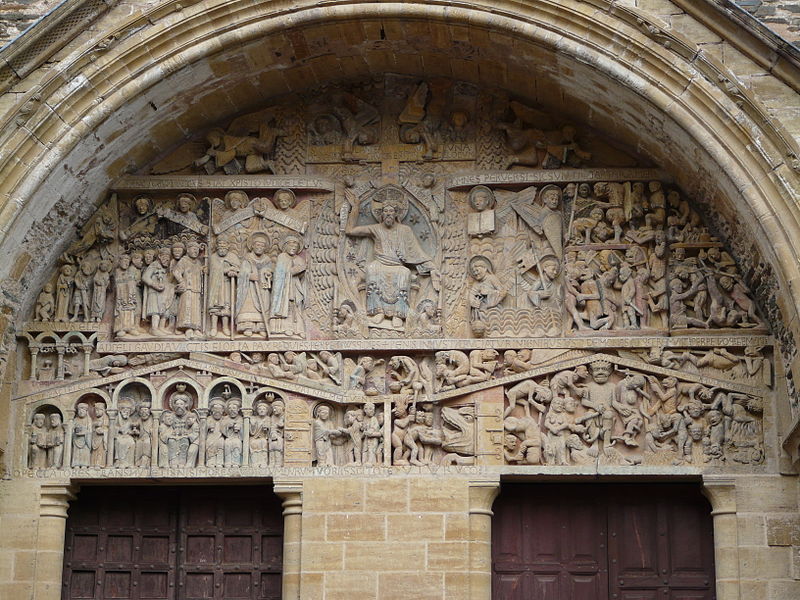
➼ Reliquary of Sainte-Foy
Details
Made of gold, silver, gemstones, and enamel over wood.
9th century, with later additions
Found in Sainte-Foy, Conques
Form
Child saint’s skull is housed in the rather mannish-looking enlarged head.
Jewels, gems, and crown added over the years by the faithful, as acts of devotion.
Facial expression is haughty and severe.
Function: Reliquary of a young girl martyred in the early fourth century.
Context
Sainte Foy (or Faith) probably died as a martyr to the Christian faith during the persecutions in 303 under Emperor Diocletian; she was tortured over a brazier; she refused to sacrifice to the Roman gods in a pagan ritual.
Saint Foy, triumphant over death, looking up and over the viewer’s head.
Relics of her body were stolen from a nearby town and enthroned in Conques in 866.
One of the earliest large-scale sculptures in the Middle Ages.
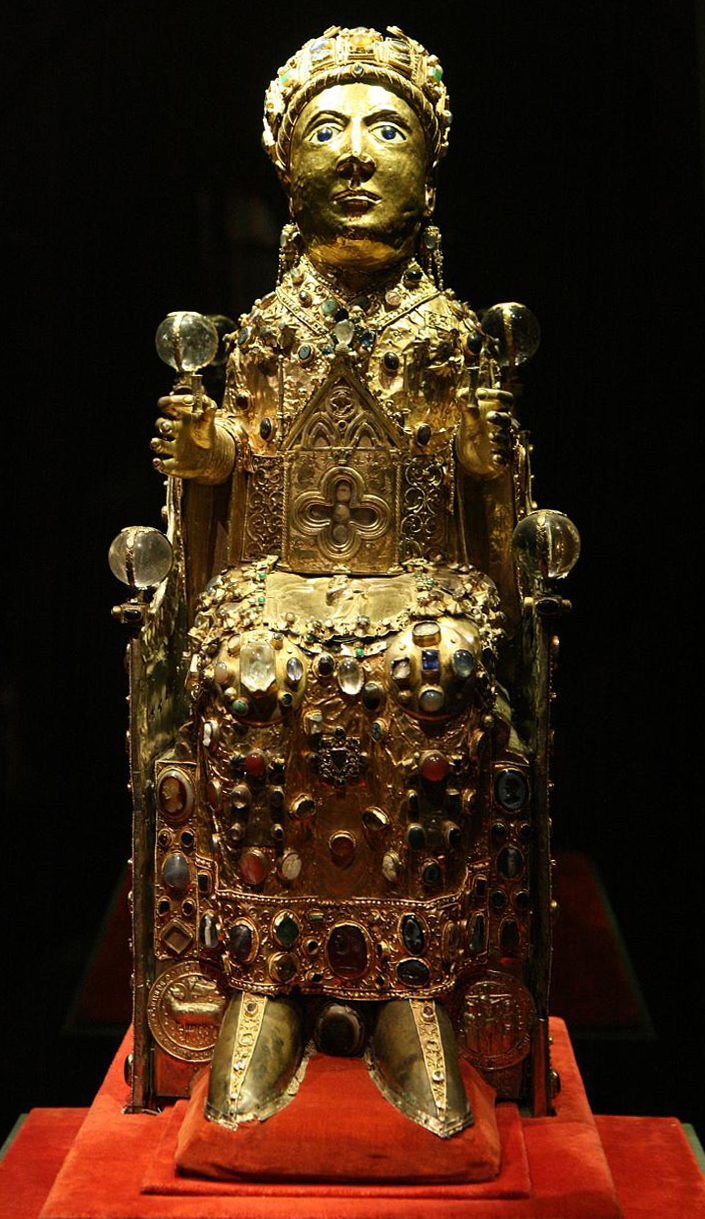
➼ The Bayeux Tapestry
Details
Romanesque Europe (English or Norman)
1066–1080
Made of embroidery on linen
Found in Bayeux Tapestry Museum, Bayeux, France
Form
Color used in a decorative, although unnatural, manner—different parts of a horse are colored variously.
Neutral background of unpainted fabric.
Flat figures; no shadows.
Content
Tells the story (in Latin) of William the Conqueror’s conquest of England at the Battle of Hastings in 1066.
The story, told from the Norman point-of-view, emphasizes the treachery of Harold of England, who breaks his vow of loyalty and betrays William by having himself crowned.
More than 600 people, 75 scenes.
Fanciful beasts in upper and lower registers.
Borders sometimes comment on the main scenes or show scenes of everyday life.
Function
Uncertainty over how this work was meant to be displayed, perhaps in a cathedral hung from the pillars in the nave or hung in a hall along a wall.
Technique
Tapestry is a misnomer; actually, it’s an embroidery.
Probably designed by a man and executed by women.
Patronage: Commissioned by Bishop Odo, half-brother to William the Conqueror.
Context
Continues the narrative tradition of medieval art; 230 feet long.
Narrative tradition goes back to the Column of Trajan
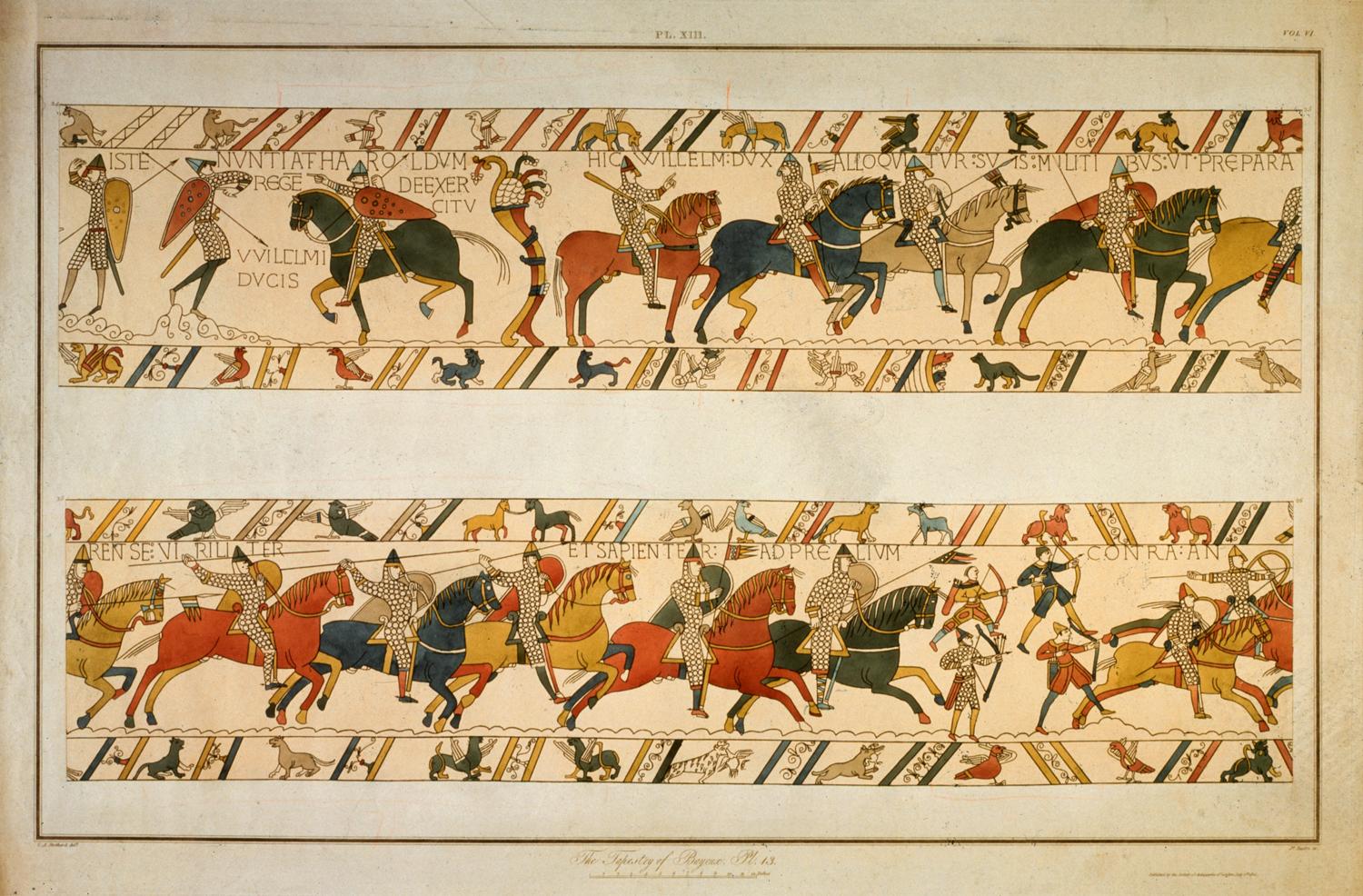
➼ Chartres Cathedral
Details
Gothic Europe
c. 1145–1155, reconstructed 1194–1220
Made of limestone and stained glass
Found in Chartres, France
Form
The first church to have flying buttresses as part of the original design; earlier churches retrofitted flying buttresses after the building was constructed.
The tall vertical nature of the interior pulls the viewer’s eyes up to the ceiling and symbolically to heaven; rib vaulting increases the ceiling’s vertical thrust.
Lancets and spires add to the verticality of the building.
Spire or Steeple: a tall pointed tower on a church
The dark, mysterious interior increases a spiritual feeling.
Stained glass enlivens the interior surfaces of the church.
The façade contains a gallery of Old Testament figures above a rose window.
Enlarged chevet accommodates elaborate church ceremonies.
Function: Christian church dedicated to the Virgin Mary; a Marian shrine.
Context
Started in 1145; fire in 1194 forced reconstruction of everything except the façade.
Mary’s tunic, worn at Jesus’s birth, is its most sacred relic; its escape from a fire in 1194 was seen as a signal to rebuild the cathedral.
Right spire is from 1160; left spire is Late Gothic (1507–1513), a style more elaborate and decorative called Flamboyant Gothic.
Importance of the church reflected in the speed of construction: 27 years.
Each wing of the cathedral faces a cardinal direction of the compass:
The west wing is the entrance, facing sunset and symbolizing the end of the world.
The north wing has stained-glass windows that symbolize the past.
The south wing has stained-glass windows that symbolize the presentworld depicted in the New Testament.
The east wing has the apse and altar, located where the sun rises.
Part of a complex that included a school, a bishop’s palace, and a hospital.
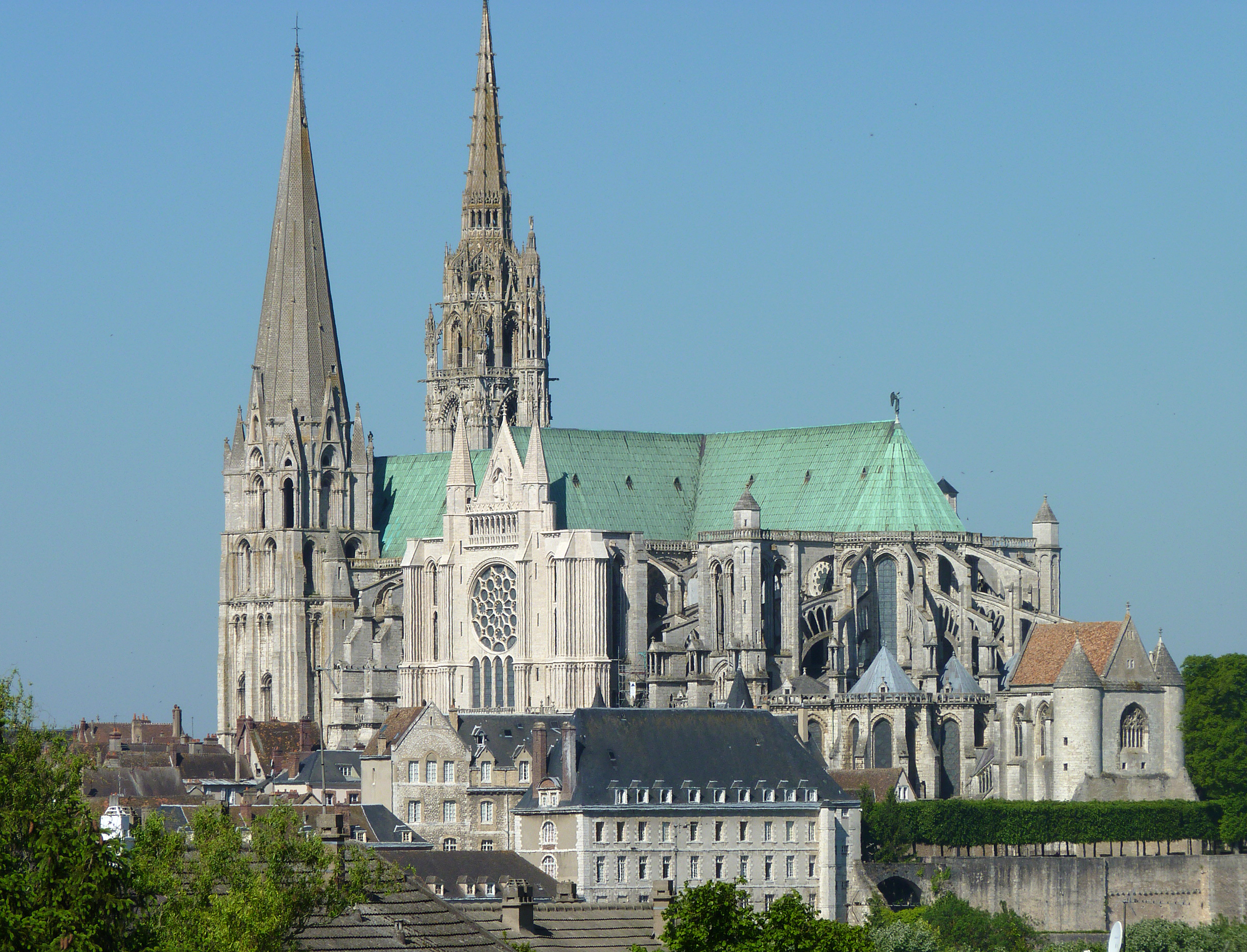
➼ Notre Dame de la Belle Verriere
Details
“Our Lady of the Beautiful Window”
c. 1170
A stained glass
Found in Chartres Cathedral
Function:
Part of a lancet stained-glass window in Chartres Cathedral.
Lancet: a tall narrow window with a pointed arch usually filled with stained glass
Context
Mary, the throne of wisdom, is crowned Queen of Heaven with the Christ Child on her lap.
Color patterns on the cathedral's gray stone represent the divine.
Bands across the surface are typical of Early Gothic stained glass.
Undamaged by the fire of 1194, it was reset with blue framing and framing angels on either side of the main scene, contrasting the two stained glass styles in the same window.

➼ Scenes from the Apocalypse
Details
From a Bible moralisée (Moralized Bible), Gothic Europe
c. 1225–1245
Made of illuminated manuscript, ink, tempera, and gold leaf on vellum
Found in Cathedral, Toledo
Apocalypse: the last book of the Christian Bible, sometimes called Revelations, which details God’s destruction of evil and consequent raising to heaven of the righteous
Moralized Bible: a Bible in which the Old and New Testament stories are paralleled with one another in illustrations, text, and commentary
Form
Eight medallions; format derives from the stained-glass windows.
Luminosity of text a reflection of stained-glass windows; strong black outlining of forms.
Two vertical columns of four painted scenes.
Modeling is minimal.
Function: Moralized Bible.
Content
Each scene has a text with a summary of the event depicted in the roundel.
Old and New Testament scenes are paired as complementing one another.
Context: Done for the royal court at Paris.
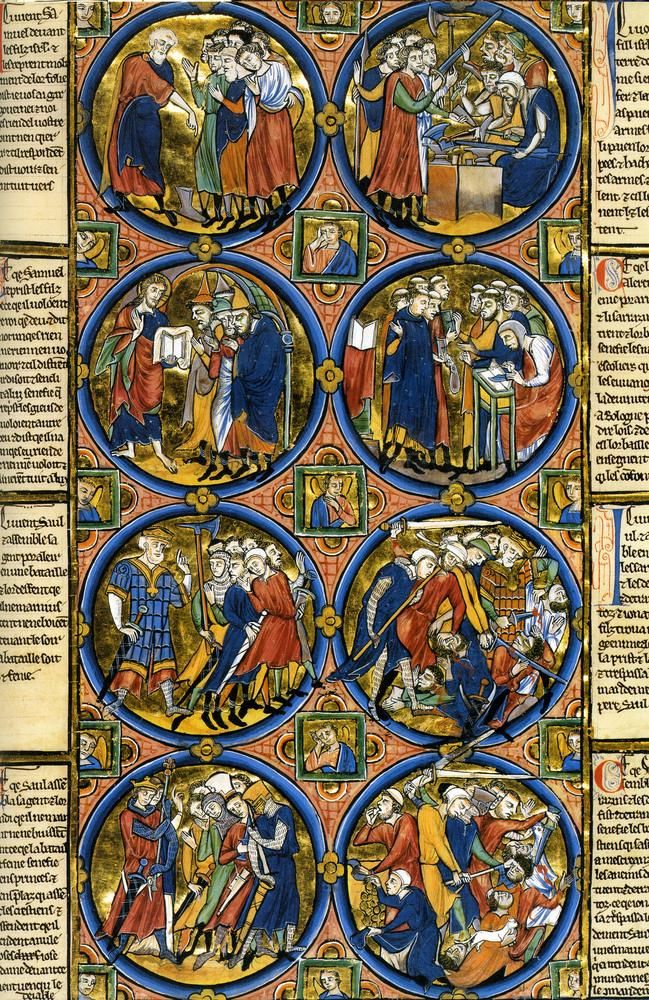
➼ Golden Haggadah
Details
(The Plagues of Egypt, Scenes of Liberation, and Preparation for Passover),
From late medieval Spain
c. 1320
Made of illuminated manuscript, pigments and gold leaf on vellum
Found in British Library, London
Passover: an eight day Jewish festival that commemorates the exodus of Jews from Egypt under the leadership of Moses.
Form
Style similarities to French Gothic manuscripts in the handling of space, architecture, figure style, facial/gestural expression, and the manuscript medium itself.
56 miniatures; gold leaf background.
Function and Content
A Haggadah is a book that illustrates the story of the Jewish exodus from Egypt under Moses and its subsequent celebration.
It contains a narrative cycle of events from the books of Genesis and Exodus.
It is to be read at a Passover Seder.
This Haggadah was used primarily at home, therefore avoiding the more stringent restriction against holy images in a synagogue.
Context
Haggadah means “narration”; fulfills the Jewish requirement to tell the story of the Jewish escape from Egypt as a reminder of God’s mercy.
Haggadot (plural) are generally the most lavishly painted of Jewish manuscripts.
The book is read right to left according to the manner of Hebrew texts.
Two unknown artists, probably Christian, illustrated the Golden Haggadah; a Jewish scribe wrote the Hebrew script.
Painted around the Barcelona area of Spain.
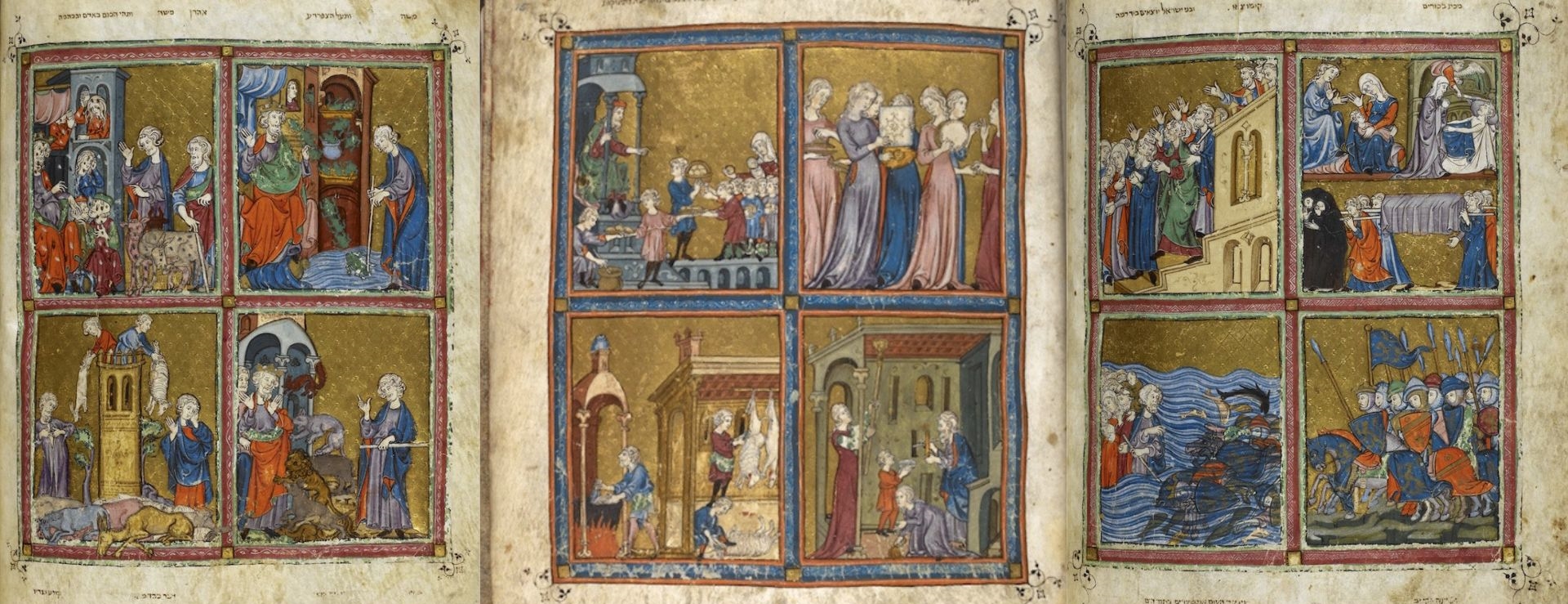
➼ Arena (Scrovegni) Chapel
Details
Unknown architext
c. 1303, brick
Found in Padua, Italy
Context
The Arena Chapel was built by an unknown architect over an ancient Roman arena.
It is also called the Scrovegni Chapel after the name of the patron, Enrico Scrovegni.
It was built to expiate the sin of usury through which Scrovegni’s father amassed a fortune; shows the rise of patronage from the European business class.
Some narrative scenes illustrate biblical episodes of ill-gotten gains.
The life of Christ appears on one side of the chapel, the life of Mary on the other.
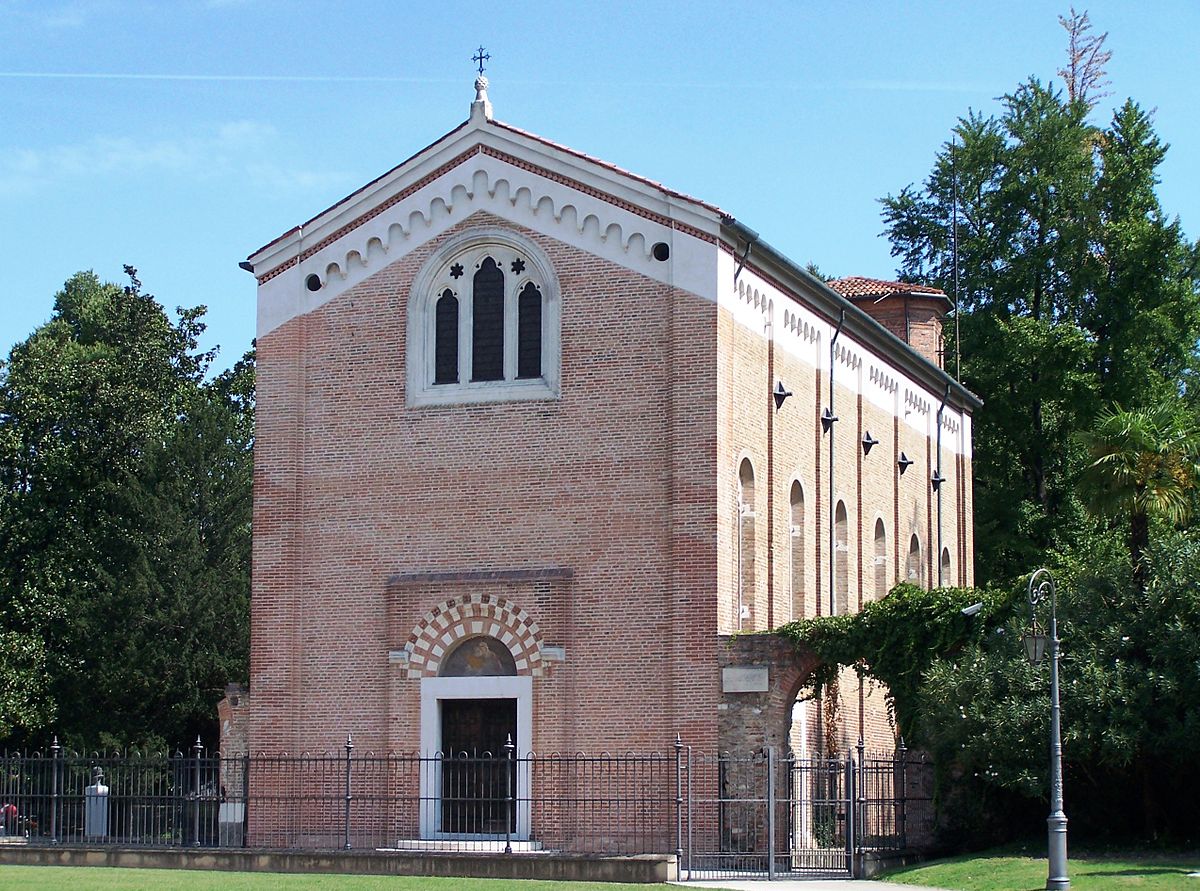
➼ Last Judgment from the Arena Chapel
Details
Painted by Giotto
1305
A fresco painting.
Found in Padua, Italy
Last Judgment: in Christianity, the judgment before God at the end of the world
Content
Christ as judge, coming at the end of the world.
Heavenly powers are arranged in an organized chorus; heads aligned in a row.
Twelve apostles are arranged symmetrically around Christ.
Cross at bottom center divides the saved from the damned.
On the side of the saved is Enrico Scrovegni in his role as donor presenting a model of the church to angels.
At right is the devil, who eats and excretes sinners.
Those guilty of usury or money-related sins like prostitution are particularly noted.

➼ Lamentation from the Arena Chapel
Details
Painted by Giotto
1305
A fresco painting.
Found in Padua, Italy
Lamentation: scenes that show Jesus’s followers mourning his death. Usually the scene contains Mary, Saint John, and Mary Magdalene
Form
Shallow stage; figures occupy a palpable space pushed forward toward the picture plane.
Diagonal cliff formation points to main action daringly placed in lower left-hand corner.
Modeling indicates direction of light; light falls from above right.
Figures seen from the back isolate the main action.
Content
Lamentation shows scenes of Jesus’s followers mourning his death. Usually the scene contains Mary, Saint John, and Mary Magdalene.
Saint John throws his hands back—recalling his iconographic symbol as an eagle; Mary Magdalene cradles Jesus’s feet; Mary holds Jesus’s head.
At left is the Old Testament scene of Jonah being swallowed by the whale and returning to life, a parallel with the New Testament scene of Christ dying and rising from the dead.
Range of emotions: heavy sadness, quiet resignation, flaming outbursts, despair.
Sadness of scene emphasized by grieving angels.
Leafless tree echoes the theme of death in the painting; also represents the tree of the knowledge of good and evil in the Garden of Eden, which dies after Adam and Eve are expelled; a dead tree also symbolizes the wood of the cross Jesus was crucified on.
Christians believe Jesus sacrificed himself, in part, to expiate the expulsion from the Garden of Eden.
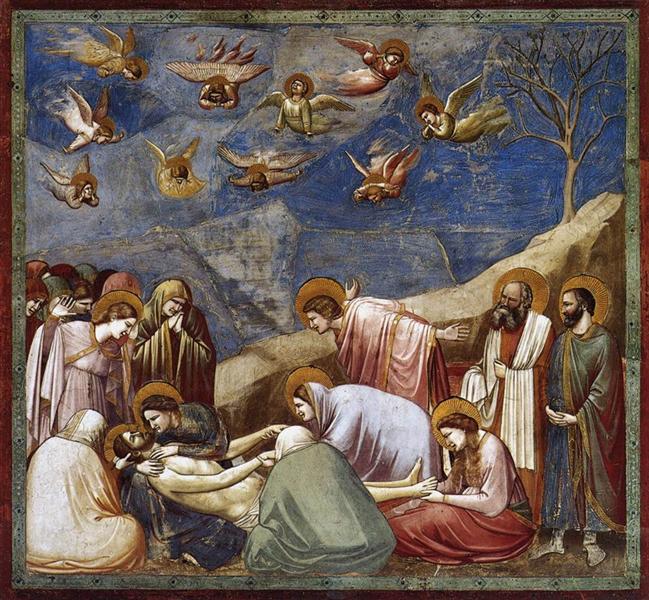
➼ Annunciation Triptych
Details
Robert Campin workshop
also called Merode Altarpiece
1427–1432
An oil on wood
Found in Metropolitan Museum of Art, New York
Form
Annunciation: in Christianity, an episode in the Book of Luke 1:26–38 in which Angel Gabriel announces to Mary that she would be the Virgin Mother of Jesus
Triptych: a three-paneled painting or sculpture
Triptych, or three-paneled altarpiece.
Meticulous handling of paint; intricate details are rendered through the use of oil paint.
Steep rising of the ground line; figures too large for the architectural space they occupy.
Function: Meant to be in a private home for personal devotion.
Technique
Oil paint gives the surface a luminosity and shine.
Oil allows for layers of glazes that render soft shadows.
Oil can also be erased with turpentine, allowing for changes and corrections.
Content
Left panel: donors, middle-class people kneeling before the holy scene.
Messenger appears at the gate to an enclosed garden.
Center panel: Annunciation taking place in an everyday Flemish interior.
Symbolism
Towels and water represent Mary’s purity; water is a baptism symbol.
Flowers have three buds, symbolizing the Trinity; the unopened bud represents the unborn Jesus.
Mary is seated on a kneeler near the floor, symbolizing her humility.
Mary blocks the fireplace, the entrance to hell.
The candlestick symbolizes Mary holding Christ in the womb.
The Holy Spirit with a cross comes in through the window, symbolizing the divine birth.
Humanization of traditional themes: no halos, domestic interiors, view into a Flemish cityscape.
Right panel: Joseph is working in his carpentry workshop; the mousetraps on the windowsill and the workbench symbolize the capturing of the devil.
The mousetraps on the bench and in the shop window opening onto the street are thought to allude to references in the writings of Saint Augustine identifying the cross as the devil’s mousetrap.
Context
Unusually, the main panel was not commissioned.
Wings were commissioned when the main panel was purchased; the donor portrait was added at this time.
Donor: a patron of a work of art, who is often seen in that work
After the donor’s marriage in the 1430s, the wife and messenger were added, which accounts for the rather squeezed-in look of the donor’s wife.
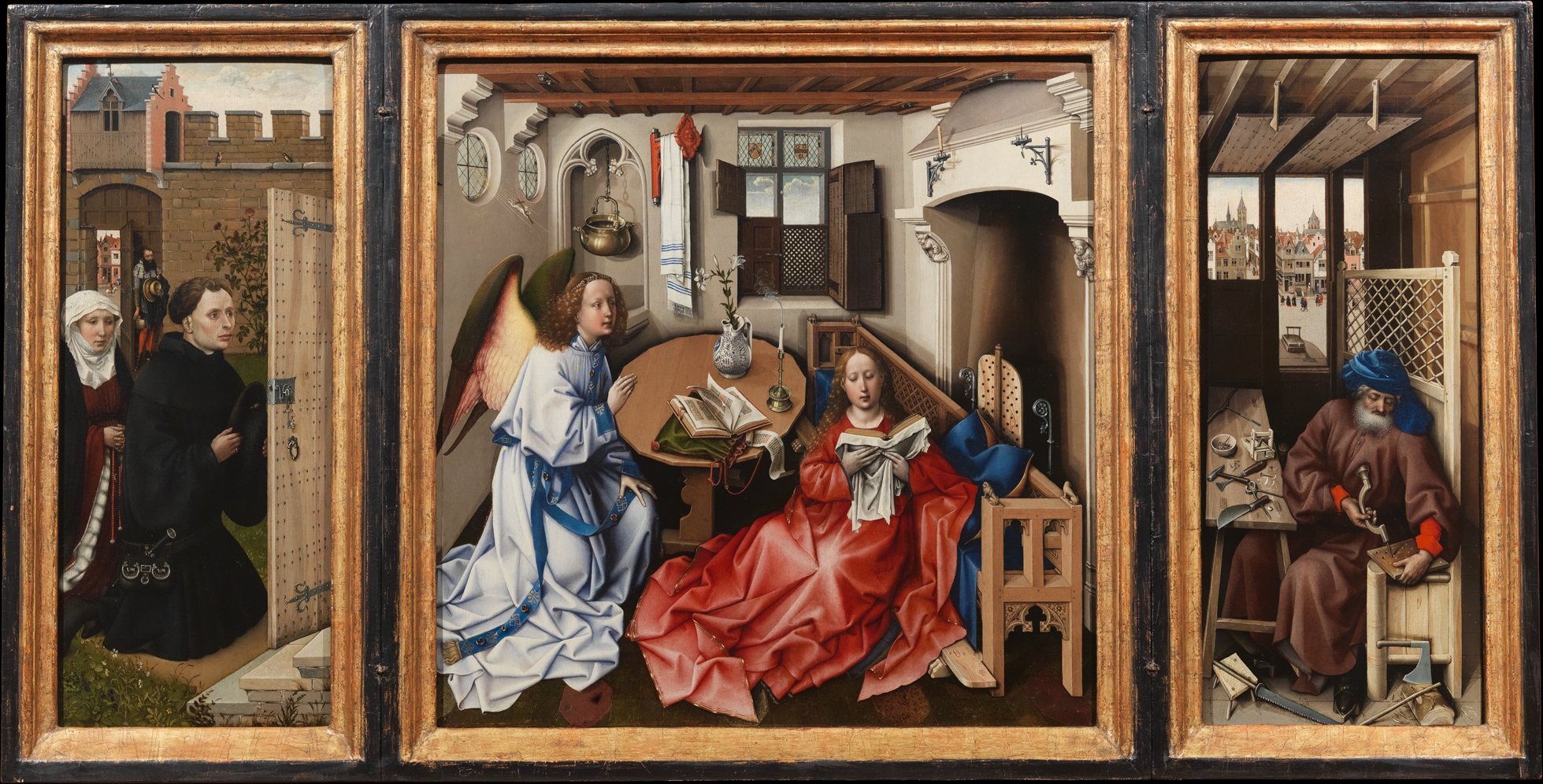
➼ Arnolfini Portrait
Details
Painted by Jan van Eyck.
1434
An oil on wood
Found in National Gallery, London
Form
Meticulous handling of oil paint; great concentration of minute details.
Linear perspective, but upturned ground plane and two horizon lines unlike contemporary Italian Renaissance art.
Great care is taken in rendering elements of a contemporary Flemish bedroom.
Theories
Traditionally assumed to be the wedding portrait of Giovanni Arnolfini and his wife.
It may be a memorial to a dead wife, who could have died in childbirth.
It may represent a betrothal.
Arnolfini may be conferring legal and business privileges on his wife during an absence.
The painting may have been meant as a gift for the Arnolfini family in Italy.
It had the purpose of showing the prosperity and wealth of the couple depicted.
Context
Symbolism of weddings:
The custom of burning a candle on the first night of a wedding.
Shoes are cast off, indicating that the couple is standing on holy ground.
The groom is in a promising pose.
The dog symbolizes fidelity.
Two witnesses in the convex mirror; perhaps the artist himself, since the inscription reads “Jan van Eyck was here 1434.”
The woman pulls up her dress to symbolize childbirth, although most likely she is not pregnant; the gesture may simply be a fashion of the time.
Statue of Saint Margaret, patron saint of childbirth, appears on the bedpost.
The man is standing near the window, symbolizing his role as someone who makes his way in the outside world; the woman appears further in the room to emphasize her role as a homemaker.
Wealth is displayed in the opulent furnishings, the elaborate clothing, and the importing of fresh oranges from southern Europe.
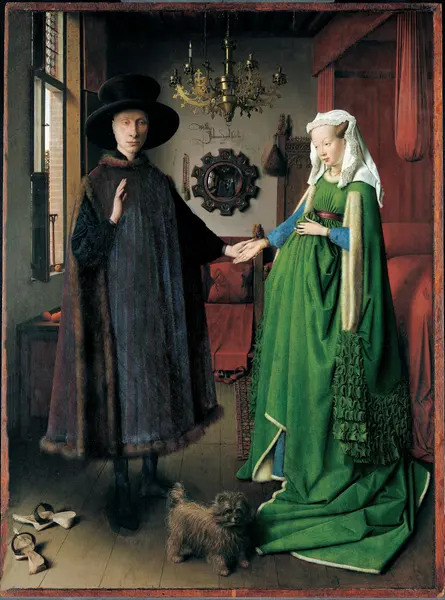
➼ Adam and Eve
Details
Engraved by Albrecht Dürer
An engraving
Found in Metropolitan Museum of Art, New York
Form
Influenced by classical sculpture; Adam looks like the Apollo Belvedere, and Eve looks like Medici Venus.
Italian massing of forms, which he learned from his Italian trips.
Ideal image of humans before the Fall of Man (Genesis 3).
Contrapposto of figures from the Italian Renaissance, in turn also based on classical Greek art.
Northern European devotion to detail.
Content
Four humors are represented in the animals:
cat (choleric, or angry),
rabbit (sanguine, or energetic),
elk (melancholic, or sad),
ox (phlegmatic, or lethargic);
The four humors were kept in balance before the Fall of Man;
The humors fell out of balance after the successful temptation of the serpent.
The mouse represents Satan.
The parrot is a symbol of cleverness.
Adam tries to dissuade Eve; he grasps the mountain ash, a tree from which snakes recoil.
Context: Prominent placement of the artist’s signature indicates the rising status of his occupation.
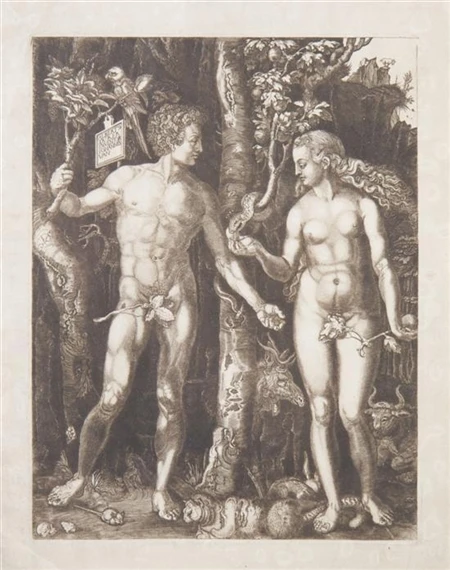
➼ Allegory of Law and Grace
Details
Made by Lucas Cranach the Elder
c. 1530,
A woodcut and letterpress
Function
Designed using the woodcut technique to make the image available to the masses.
Its purpose was to contrast the benefits of Protestantism versus the perceived disadvantages of Catholicism.
Influential image of the Protestant Reformation; text appears in the people’s language: German, and not the church language: Latin.
Context
Protestantism: the faithful achieve salvation by God’s grace; guidance can be achieved using the Bible.
Meant to reflect the Lutheran ideas about salvation.
Done in consultation with Martin Luther, a leader in the Protestant movement.
Left: Last Judgment
Moses holds the Ten Commandments.
The Ten Commandments represent the Old Law, Catholicism.
The Law of Moses is not enough; it is not enough to live a good life.
A skeleton chases a man into hell.
Right: Figure bathed in Christ’s blood
Faith in Christ alone is needed for salvation.
Symbolically, the barren branches of the tree on the left side contrast with the full bloom on the right.
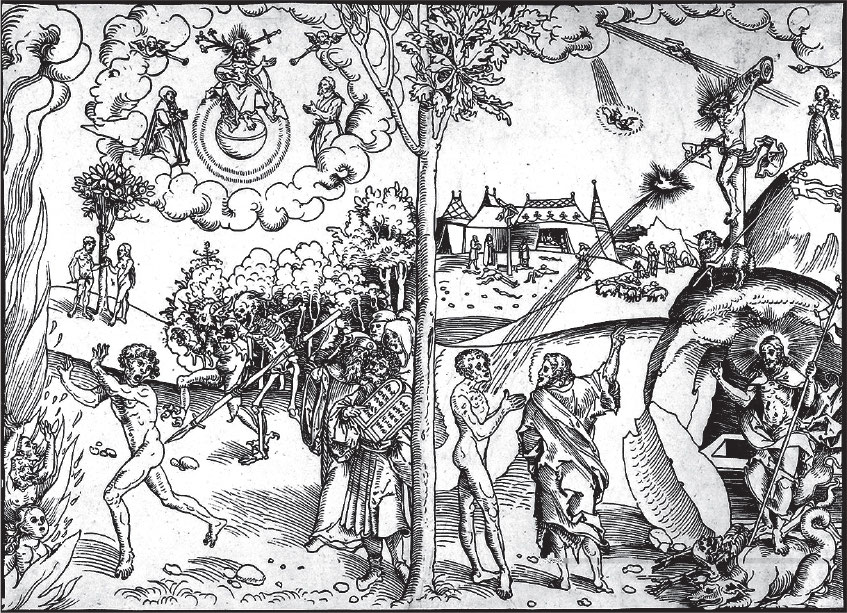
➼ Hunters in the Snow
Details
Painted by Pieter Bruegel the Elder
1565
An oil on wood
Found in Art History Museum, Vienna
Form
Alpine landscape; typical winter scene inspired by the artist’s trips across the Alps to Italy.
Strong diagonals lead the eye deeper into the painting.
Figures are peasant types, not individuals.
Landscape has high horizon line with panoramic views, a Northern European tradition.
Extremely detailed.
Function
ne of a series of six paintings representing the labors of the months—this winter scene is November/December.
Placed in a wealthy Antwerp merchant’s home.
Patrons were wealthy individuals of high status; Bruegel’s paintings offered them a view of the world of the peasants.
Context
Hunters have had little success in the winter hunt; dogs are skinny and hang their heads.
Peasants in the sixteenth century were regarded as buffoons or figures of fun;
Bruegel does not give them individuality but does treat them with respect
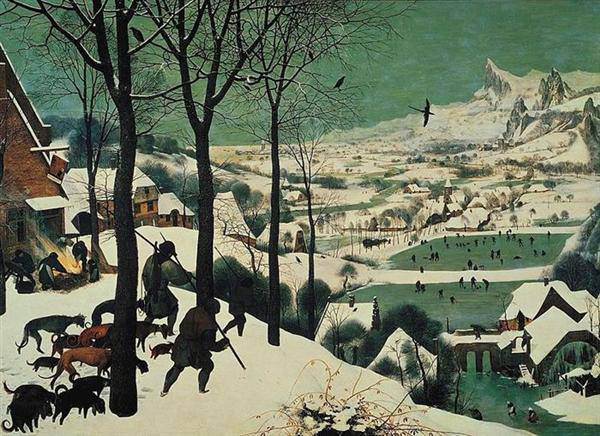
➼ Pazzi Chapel
Details
Designed by Filippo Brunelleschi
Basilica di Santa Croce
Designed 1423; Built 1429–1461,
A masonry,
Found in Florence, Italy
Form
Two barrel vaults on the interior; small dome over crossing; pendentives support dome; oculus in the center.
Interior has a quiet sense of color with muted tones that is punctuated by glazed terra cotta tiles.
Use of pietra serena (a grayish stone) in contrast to whitewashed walls accentuates basic design structure.
Pietra serena: a dark-gray stone used for columns, arches, and trim details in Renaissance buildings
Inspired by Roman triumphal arches.
Ideal geometry in the plan of the building.
Function
Chapter house: a meeting place for Franciscan monks; bench that wraps around the interior provides seating for meetings.
Rectangular chapel with an apse and an altar attached to the church of Santa Croce, Florence.
Attribution
Attribution of portico by Brunelleschi has been recently questioned;
The building may have been designed by Bernardo Rossellino or his workshop.
Patronage
Patrons were the wealthy Pazzi family, who were rivals of the Medici.
The family coat-of-arms, two outward facing dolphins, is placed at the base of each pendentive on the interior.

➼ Birth of Venus
Details
Painted by Sandro Botticelli
c. 1484–1486
Tempera on canvas
Found in Uffizi, Florence
Form
Crisply drawn figures.
Landscape flat and unrealistic; simple V-shaped waves.
Figures float, not anchored to the ground.
Content
Venus emerges fully grown from the foam of the sea with a faraway look in her eyes.
Roses scattered before her; roses created at the same time as Venus, symbolizing that love can be painful.
On the left: Zephyr (west wind) and Chloris (nymph).
On the right: handmaiden rushes to clothe Venus.
Context
Medici commission; may have been commissioned for a wedding celebration.
Painting based on a popular court poem by the writer Poliziano, which itself is based on Homeric hymns and Hesiod’s Theogony.
A revival of interest in Greek and Roman themes can be seen in this work.
Earliest full-scale nude of Venus in the Renaissance.
Reflects emerging Neoplatonic thought.
Neoplatonism: a school of ancient Greek philosophy that was revived by Italian humanists of the Renaissance
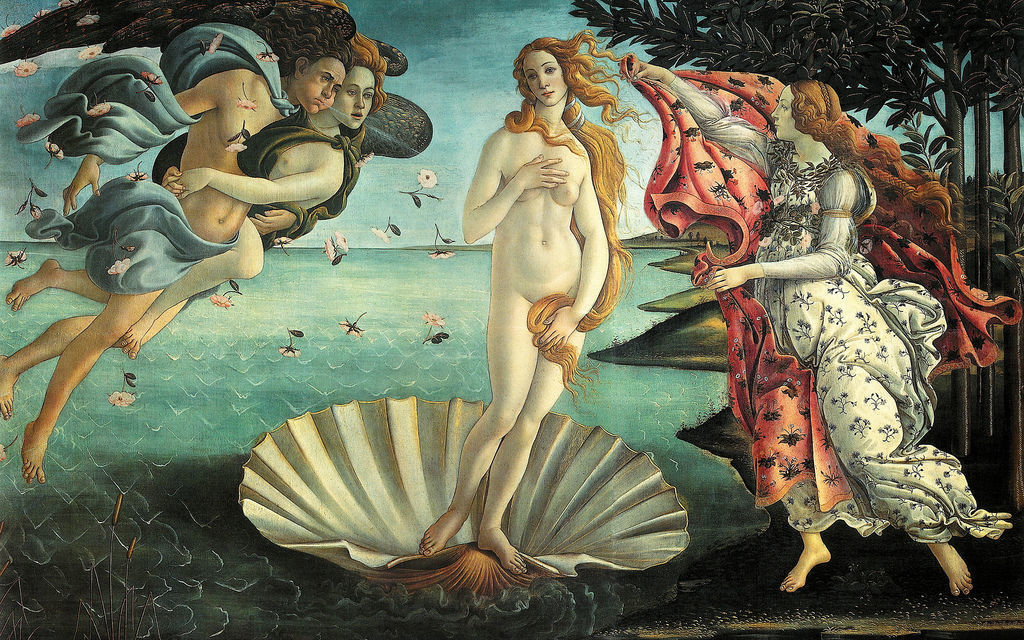
➼ The Last Supper
Details
Painted by Leonardo da Vinci
1494–1498
Made of tempera and oil,
Found in Santa Maria delle Grazie, Milan
Last Supper: a meal shared by Jesus Christ with his apostles the night before his death by crucifixion
Form
Linear perspective; orthogonals of ceiling and floor point to Jesus.
Apostles are grouped in sets of three
Jesus is alone before a group of three windows, a symbol of the Trinity.
A rounded pediment over Jesus’s head acts as a symbolic halo; Leonardo subtlety suggests Jesus’s divinity.
Function
Painted for the refectory, or dining hall, of an abbey of friars.
A relationship is drawn between the friars eating and a biblical meal.
Patronage: Commissioned by the Sforza family of Milan for the refectory of a Dominican abbey.
Materials
Leonardo experimented with a combination of paints to yield a greater chiaroscuro.
The paints began to peel off the wall in Leonardo’s lifetime.
As a result, the painting has been restored many times and is a shadow of itself.
Content
Great drama of the moment: Jesus says, “One of you will betray me” (Matthew 26:21); Jesus also blesses the bread and wine, creating a sacred Eucharist (Matthew 26:26–27).
Various reactions on the faces of the apostles: surprise, fear, anger, denial, suspicion; anguish on the face of Jesus.
Judas, the betrayer, falls back clutching his bag of coins; his face is symbolically in darkness.
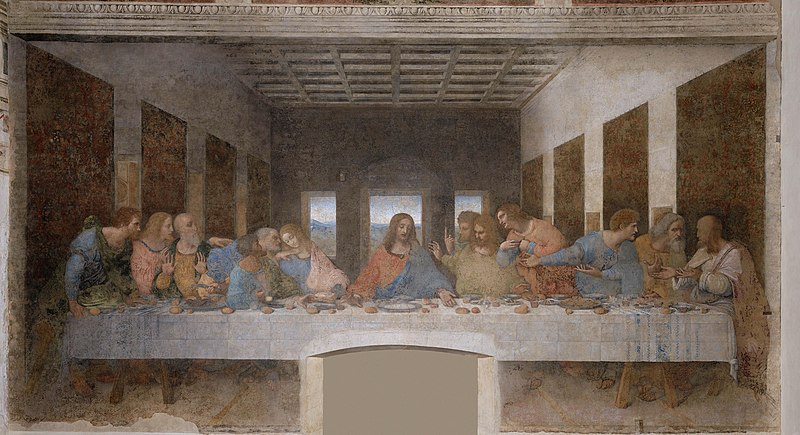
➼ Sistine Chapel ceiling
Details
By Michelangelo
1508–1512
Made of fresco
Found in Vatican City, Italy
Form
Masculine modeling of forms.
Bold, direct, powerful narrative expression.
Function
Function of the chapel: the place where new popes are elected and where papal services take place.
Name derives from Pope Sixtus IV, who was the patron of the building’s redesign between 1473 and 1481.
Content
Michelangelo chose a complicated arrangement of figures for the ceiling, which broadly illustrates the first few chapters of Genesis in nine scenes, with accompanying Old Testament figures and antique sibyls
The grand and massive figures are meant to be seen from a distance, but also echo the grandeur of the Biblical narrative.
300 figures on the ceiling, with no two in the same pose; a tribute to Michelangelo’s lifelong preoccupation with the male nude in motion.
Enormous variety of expression.
Painted cornices frame groupings of figures in a highly organized way.
Many figures are done for artistic expression rather than to enhance the narrative; the ignudi, for example.
Ignudi: nude corner figures on the Sistine Chapel ceiling
Context
Sistine Chapel was erected in 1472 and painted by quattrocento masters, including Botticelli, Perugino, and Michelangelo’s teacher, Ghirlandaio.
Quattrocento paintings are of the life of Christ and the life of Moses; Michelangelo needed a different topic for the ceiling; he chose the cosmic theme of creation.
Michelangelo’s paintings are painted over the window level of the chapel as well as the ceiling.
The chapel is dedicated to the Virgin Mary, as such the central panel on the ceiling depicts Eve, the archetype of Mary, who, according to tradition, began the redemption necessitated by the sin of Eve and Adam.
Acorns, a motif on the ceiling, were inspired by the crest of the chapel’s patron, Pope Julius II.
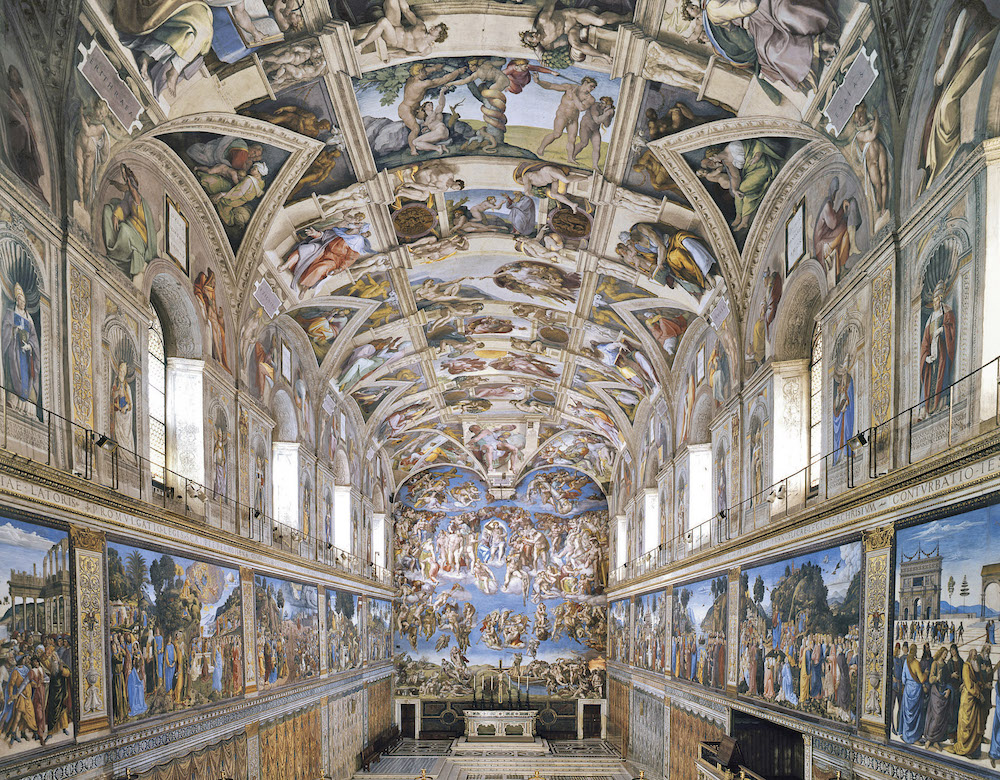
➼ The Flood
Details
By Micheangelo
1508–1512
Made of fresco
Found in Vatican City, Italy
Flood story: as told in Genesis 7 of the Bible, Noah and his family escape rising waters by building an ark and placing two of every animal aboard
Form
Sculptural intensity of the figure style.
More than 60 figures are crowded into the composition.
Function: One of the scenes on the Sistine Chapel ceiling.
Content
Story details Noah and his family’s escape from rising floodwaters, as told in Genesis 7.
The few remaining survivors cling to mountain tops; their fate will be sealed.
A man carrying his drowned son to safety will meet his son’s fate as well.
The ark in the background is the only safe haven.
The salvation of the good (as opposed to God’s destruction of the wicked) is stressed.
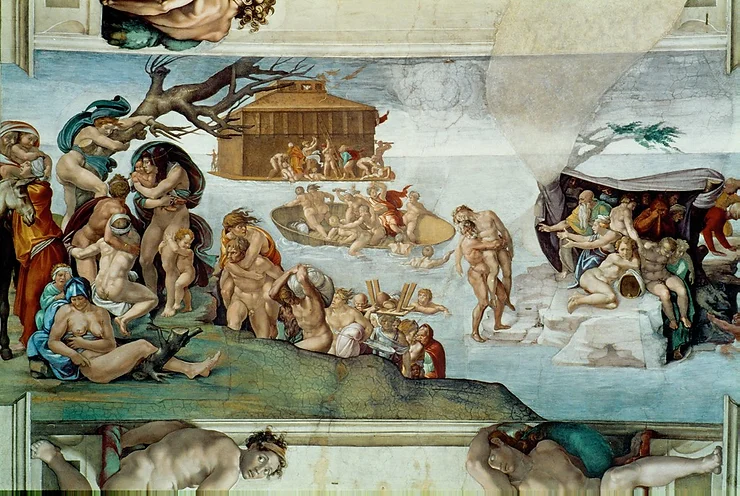
➼ Last Judgment
Details
By Michelangelo
1536–1541
Made of fresco
Found in Vatican City, Italy
Form
In contrast to the ceiling, there are no cornice divisions; it is one large space with figures greatly integrated.
The Mannerist style is shown in the distortions of the body: elongations and crowded groups.
Function
Last Judgment scenes are traditional on altar walls of chapels
This was not the original choice of subject matter for the wall.
Patronage: Pope Paul III was the patron.
Context
The subject was chosen because of the turbulence in Rome after the sack of the city in 1521.
Counter-Reformation message: the true path to salvation is through the Catholic Church.
Spiraling composition is a reaction against the High Renaissance harmony of the Sistine Ceiling and reflects the disunity in Christendom caused by the Reformation.
In the spirit of the Counter-Reformation, the genitalia were painted over after Michelangelo’s death.
Content
Four broad horizontal bands act as the unifying element:
Bottom: dead rising on the left and the mouth of hell on the right.
Second level: ascending elect, descending sinners, trumpeting angels.
Third level: those risen to heaven are gathered around Jesus.
Top lunettes: angels carrying the cross and the column, instruments used at Christ’s death.
Christ, in center, gestures defiantly with right hand; complex pose.
Justice is delivered: the good rise, the evil fall.
Lower right-hand corner has figures from Dante’s Inferno: Minos and Charon.
Saint Bartholomew’s face is modeled on a contemporary critic.
Saint Bartholomew holds his skin, a symbol of his martyrdom, but the skin’s face is Michelangelo’s, an oblique reference to critics who skinned him alive with their criticism.
It may also represent Michelangelo’s concern over the fate of his soul as expressed in his poetry.
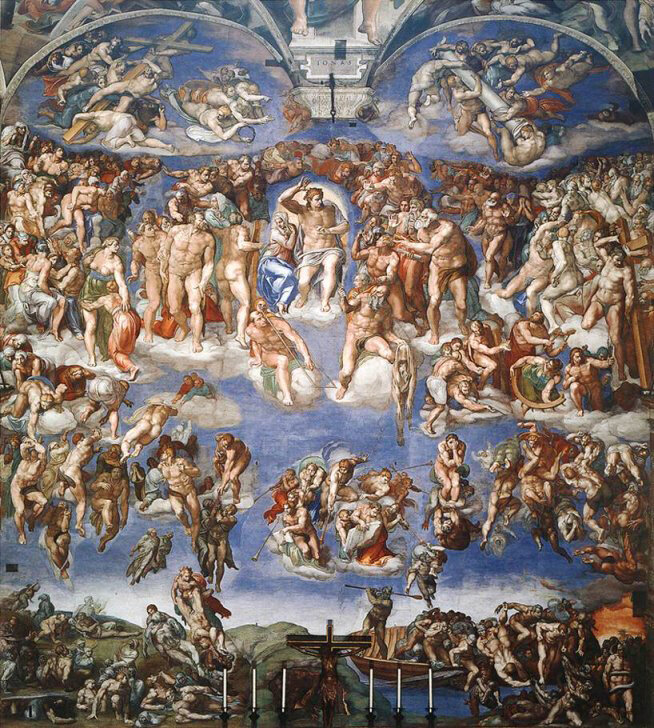
➼ School of Athens
Details
By Raphael
1509–1511
Made of fresco
Found in Apostolic Palace, Vatican City, Italy
Form
Open, clear light uniformly spread throughout the composition.
Nobility and monumentality of forms parallel the greatness of the figures represented; figures gesture to indicate their philosophical thought.
Raphael’s overall composition was influenced by Leonardo’s Last Supper
Patronage and Function
Commissioned by Pope Julius II to decorate his library.
This is one painting in a complex program of works that illustrate the vastness and variety of the papal library.
Painting originally called Philosophy because the pope’s philosophy books were meant to be housed on shelving below.
Content and Context
Opposite this work is a Raphael painting called La Disputà,
based on religion;
religious books were placed below;
parallels drawn between the two themes expressed in the paintings.
To the left of Philosophy is Apollo and the Muses on Parnassus, referencing literature.
The building depicted in the background might reflect Bramante’s plan for Saint Peter’s; Bramante appears as the bald Euclid in the lower right.
In the center are the two greatest figures in ancient Greek thought:
Plato (with the features of Leonardo da Vinci) on the left pointing up, and
Aristotle (perhaps with the features of the architect Giuliano da Sangallo) pointing out.
Their gestures reflect their philosophies.
On the left are those interested in the ideal (followers of Plato); on the right, those interested in the practical (followers of Aristotle).
Raphael is on the extreme right with a black hat.
Michelangelo, resting on the stone block writing a poem, represents the philosopher Heraclitus; the figure was added later and was not part of the original composition.
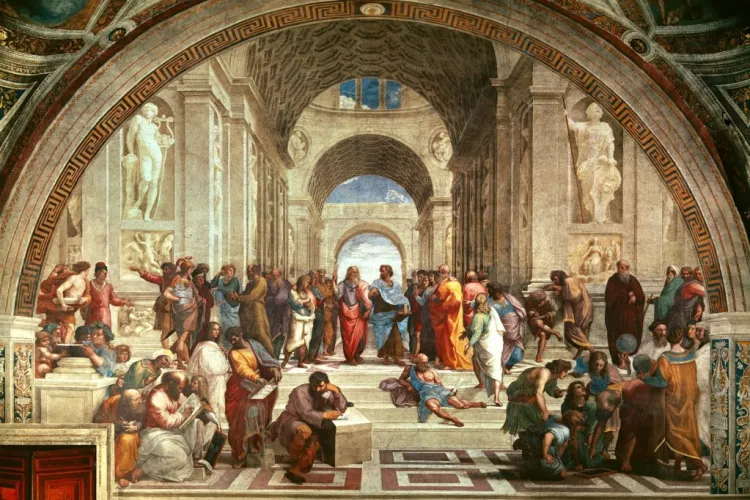
➼ Versailles
Details
By Louis Le Vau and Jules Hardouin-Mansart
Begun 1669
Made of masonry, stone, wood, iron, and gold leaf; gardens
Found in Versailles, France
Function
This is the palace of King Louis XIV and subsequent kings and their courts.
The palace expresses the idea of the absolute monarch; the massive scale of the project is indicative of the massive power of the king.
Form and History
Louis XIV reorganized and remodeled an existing hunting lodge into an elaborate palace.
The center of the building is Louis XIV’s bedroom, or audience chamber, from which all aspects of the design radiate like rays from the sun (hence Louis’ sobriquet the Sun King).
The building is centered in a vast garden and town complex that radiated from it.
There is a subdued exterior decoration on the façade; the undulation of projecting members is understated.
Hall of Mirrors
240 feet long, facing the garden façade.
Barrel-vaulted painted ceiling (paintings stress the military victories of Louis XIV; rooms that flank the Hall of Mirrors are thematically related, one of Peace and the other War).
Light comes in from one side and ricochets off large panes of glass, the largest that could be made at the time.
This is an example of a use of flickering light in an architectural setting.
Mirrors were among the most expensive items manufactured in the seventeenth century—the Hall of Mirrors is an extravagant display of wealth.
Mirrors were made exclusively in Venice at the time; workers had to be imported from Venice to make the mirrors, which conformed to the dictates that the decorations at Versailles had to be made in France.
Hall of Mirrors used for court and state functions: embassies, births, and marriages were celebrated in this room.
Subsequent history:
Used by Bismarck to declare William I as German emperor after the defeat of the French in the Franco-Prussian War in 1871.
Used reciprocally by the French after the defeat of the Germans in World War I to sign the Treaty of Versailles in 1919.
Gardens
Classically and harmoniously arranged.
Formal gardens near the palace; more wooded and less elaborate plantings farther from the palace.
Baroque characteristics:
Large size.
Long vistas.
Terminal views in fountains and statuary.
Geometric plantings show control of nature.
A mile-long canal crossed by another canal forms the main axis of the gardens; linked to the rising sun over the palace.
Only the fountains near the palace were turned on all the time; others were turned on only when the king progressed through the gardens.
Illustrates the belief that humans can organize and control nature to make a more refined experience.
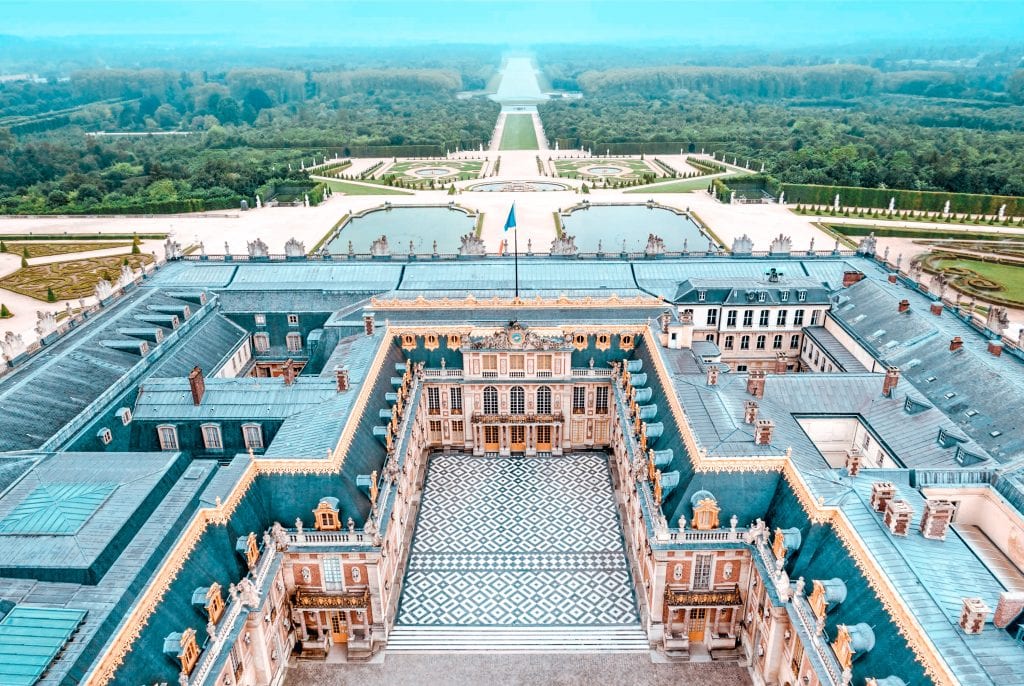
➼ Triumph of the Name of Jesus
Details
By Giovanni Battista Gaulli
1676–1679
Italian Baroque Art
Made of fresco and stucco
Found in Il Gesù, Rome
Form and Content
On the ceiling in the main nave of Il Gesù, Rome
In the center is the monogram of Jesus, IHS, in a brilliant sea of golden color.
Figures tumble below the name; some are carved in stucco and enhance the three-dimensional effect.
Some cast long shadows across the barrel vault.
Some painted figures are not stucco, but maintain a vibrant three-dimensional illusion.
It is as if the ceiling were opened to the sky and the figures are spiraling around Jesus’s name.
Depicted in the center are holy men and women.
Around the rim are priests, soldiers, noblemen, and the Magi.
Allegories of avarice, simony, heresy, and vanity occupy the lowest registers.
Di sotto in sù: a type of ceiling painting in which the figures seem to be hovering above the viewers, often looking down at us
Function
A Last Judgment scene, placed over the barrel vault of the nave; cf. Last Judgment scenes placed on the walls of chapels.
Message to the faithful: the damned are cast into hell; the saved rise heavenward.
Context
Inspired by Saint Paul’s epistle to the Philippians 2:10: “That at the name of Jesus every knee should bow, of things in heaven, and things in earth, and things under the earth.”
There is the influence of Bernini’s dramatic emotionalism in the style; Gaulli was Bernini’s pupil.
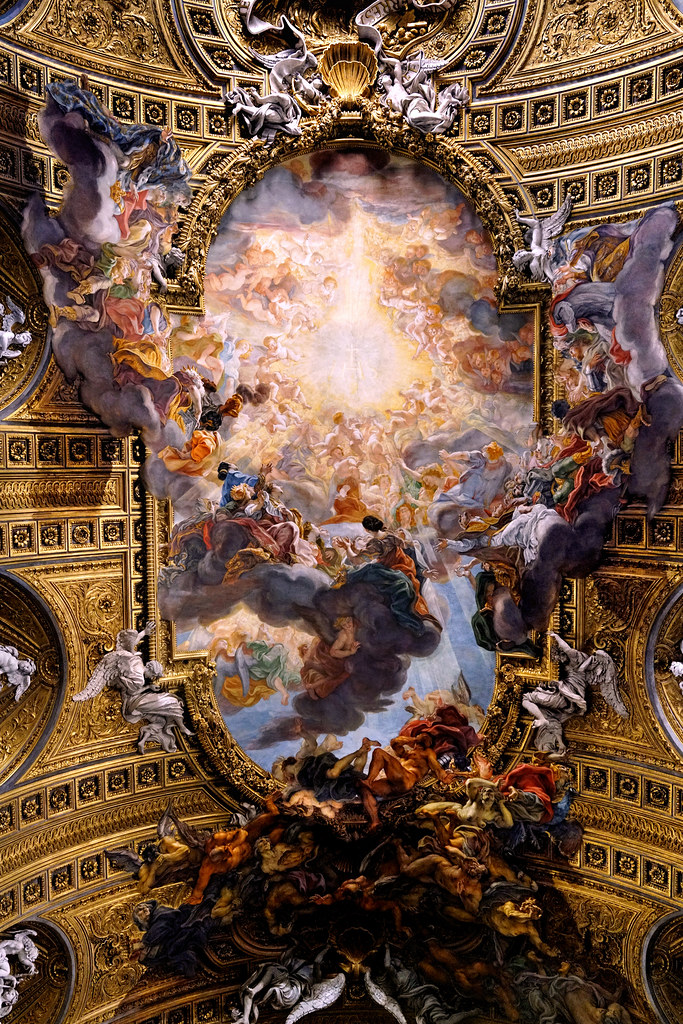
➼ Las Meninas
Details
By Diego Velázquez
1656
Spanish Baroque Art
Made of oil in canvas
Found in Prado, Madrid
Content
Portrait of the artist in his studio at work; he steps back from his very large canvas and looks at the viewer.
Central is the Infanta Margharita of Spain with her meninas (attendants), a dog, a dwarf, and a midget. Behind are two chaperones in half-shadow. In the doorway is perhaps José Nieto, who was head of the queen’s tapestry works (hence his hand on a curtain).
The king and queen appear in a mirror. But what is the mirror reflecting?
Velázquez’s canvas?
The king and queen perhaps standing in the viewer’s space—is this why people have turned around?
Or is it reflecting a painting of the king and queen on the far wall of the room?
What is the painter painting?
The royal family?
The Infanta?
A painting of this painting?
Us?
Ultimately, there is no answer, which expresses the Baroque fascination with exploring reality.
Form
Alternating darks and lights draw the viewer deeper into the canvas; the mirror simultaneously reflects out into the viewer’s space.
Dappled effect of light on shimmering surfaces.
Painterly brushstrokes seen in the sleeves of the Infanta and the hands of the artist.
Function: Painting originally hung in King Philip IV’s study.
Context
Velázquez wears the cross of the Royal Order of Santiago, which elevated him to knighthood; this work seeks to establish painting as a noble occupation.
Paintings on the back wall depict Minerva, goddess of wisdom and patroness of the arts.
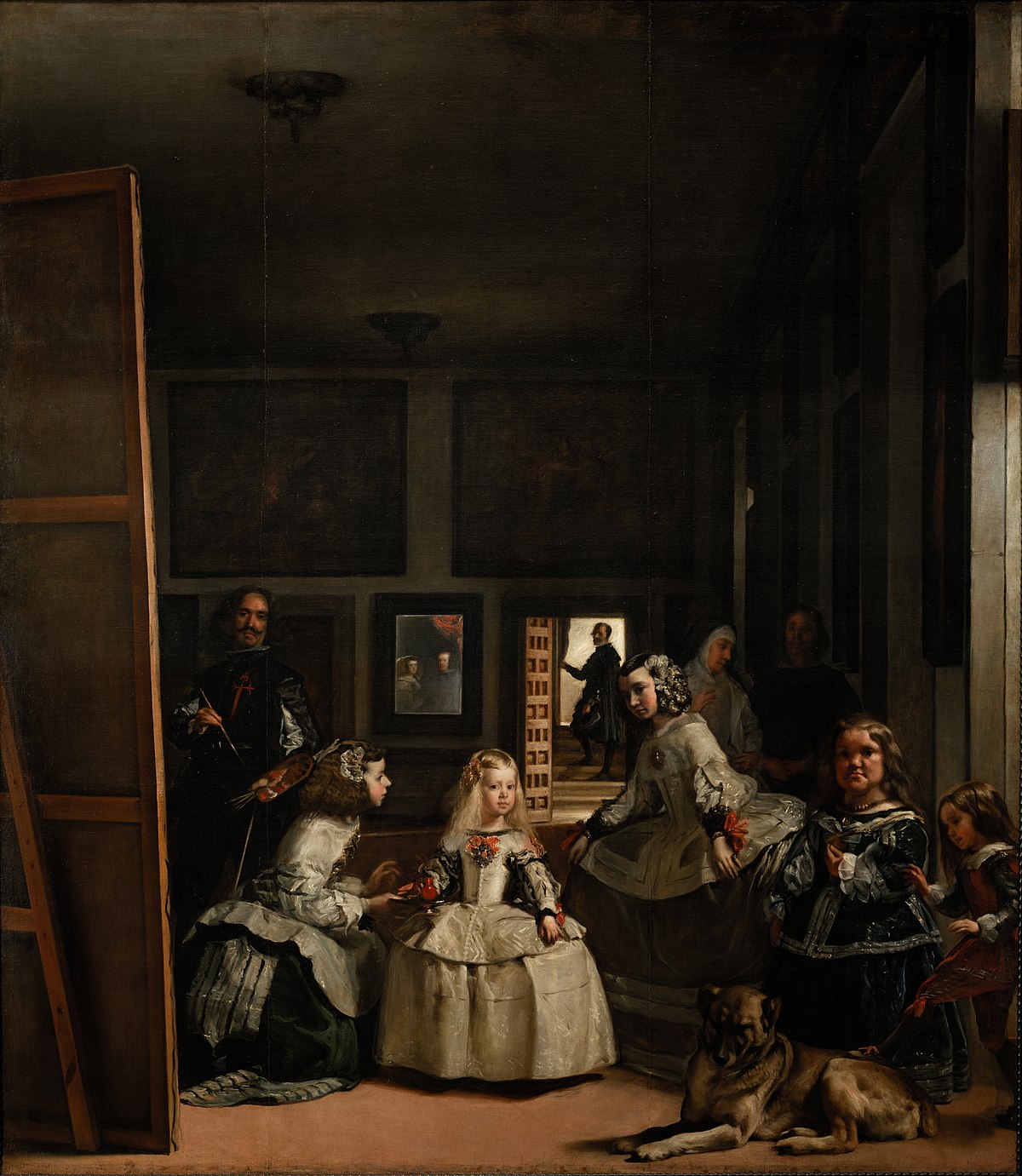
➼ Marie de’ Medici Cycle
Details
By Peter Paul Rubens
1621-1625
Flemish Baroque Art
Made of oil in canvas
Found in Louvre, Paris
Form
Heroic gestures, demonstrative spiraling figures.
Mellow intensity of color, inspired by Titian and Caravaggio.
Sumptuous full-fleshed women.
Splendid costumes suggest an opulent theatrical production.
Allegories assist in telling the story and mix freely with historical people.
Function and Context
24 huge historical paintings allegorically retelling the life of Marie de’ Medici, queen of France, wife of King Henry IV; the series also contains three portraits.
Commissioned by Marie de’ Medici, at the time the widow of Henry IV.
The series was placed in Marie de’ Medici’s home in Paris, the Luxembourg Palace.
Henri IV Receives the Portrait of Marie de’ Medici
Henry IV is smitten by the portrait of his intended; the portrait is the center of a swirling composition.
The portrait is held by Cupid (the god of love) and Hymen (the god of marriage).
Mythological gods Jupiter (symbolized by an eagle) and Juno (symbolized by a peacock) look down from below; they are symbolic of marital harmony. They express their support.
Royalty was considered demigods; the approval of mythological gods is in concert with their beliefs about themselves.
This represents the tradition of portraits being exchanged before the marriage.
They were actually married by proxy in 1600.
Behind Henry is the personification of France: –France is a female figure with a masculine helmet and manly legs. –She whispers to Henry to choose love over war.
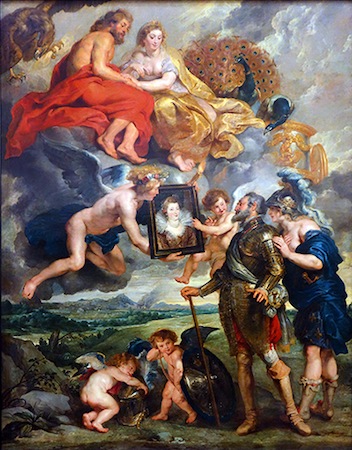
➼ Self-Portrait with Saskia
Details
By Rembrandt
1636
Dutch Baroque Art
Made of oil in canvas
Found in Art Institute of Chicago, Chicago, Illinois
Content
Rembrandt is seen drawing or perhaps making an etching.
Saskia is seated deeper into the work, but is very noticeable because she is portrayed with a lighter touch.
Function: Not for general sale but for private purposes.
Context
The scene depicts the 30-year-old Rembrandt with his new bride.
This is the only image of Rembrandt with his wife together in an etching.
Images of Saskia are abundant in Rembrandt’s output; she was a source of inspiration for him.
Marital harmony; Saskia as a muse who inspires him.
Characteristic of Rembrandt: they are wearing fanciful, not contemporary, dress.
Saskia was the mother of four.
Rembrandt’s self-portraits included 50 paintings, 32 etchings, and 7 drawings.
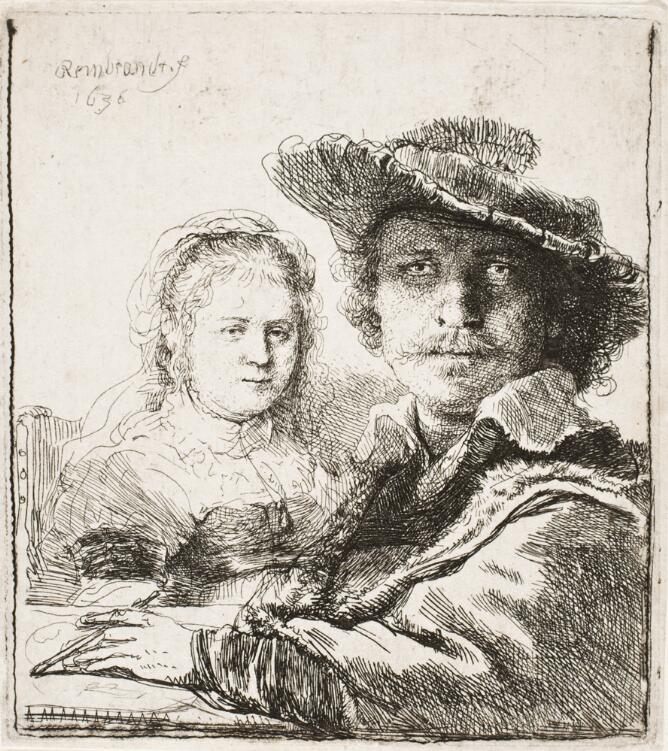
➼ Woman Holding a Balance
Details
By Johannes Vermeer
c. 1664
Dutch Baroque Art
Made of oil in canvas
Found in National Gallery of Art, Washington
Form and Content
Light enters from the left, illuminating the figures and warmly highlighting textures and surfaces: the woman’s garments, wooden table, marble checkerboard floor, jewelry, the painting, etc.
A moment in time: stillness and timelessness.
The woman is dressed in fine, fur-trimmed clothing.
Geometric lines focus on a central point at the pivot of the balance.
The figure seems unaware of the viewer’s presence.
Her pensive stillness suggests she may be weighing something more profound than jewelry.
Context
A small number of Vermeer works are in existence.
Except for two landscapes, Vermeer’s works portray intimate scenes in the interior of Dutch homes.
The viewer looks into a private world in which seemingly small gestures take on a significance greater than what first appears.
A family member may have posed for the painting, perhaps Vermeer’s wife, Caterina.
Theories
Is it a genre scene or an allegory? Or both?
A moment of weighing and judging.
In the background is a painting of the Last Judgment, a time of weighing souls:
The woman is at a midpoint between earthly jewels and spiritual goals such as meditation and temperance.
The balance (scale) has nothing in it; pearls and coins on the table waiting to be measured; may be symbolic of a balanced state of mind.
The balancing reference perhaps relates to the unborn child.
This is Catholic subject matter in a Protestant country; Vermeer and his family were Catholic.
Vanitas painting: gold should not be a false allure.
Vermeer may have used a camera obscura.
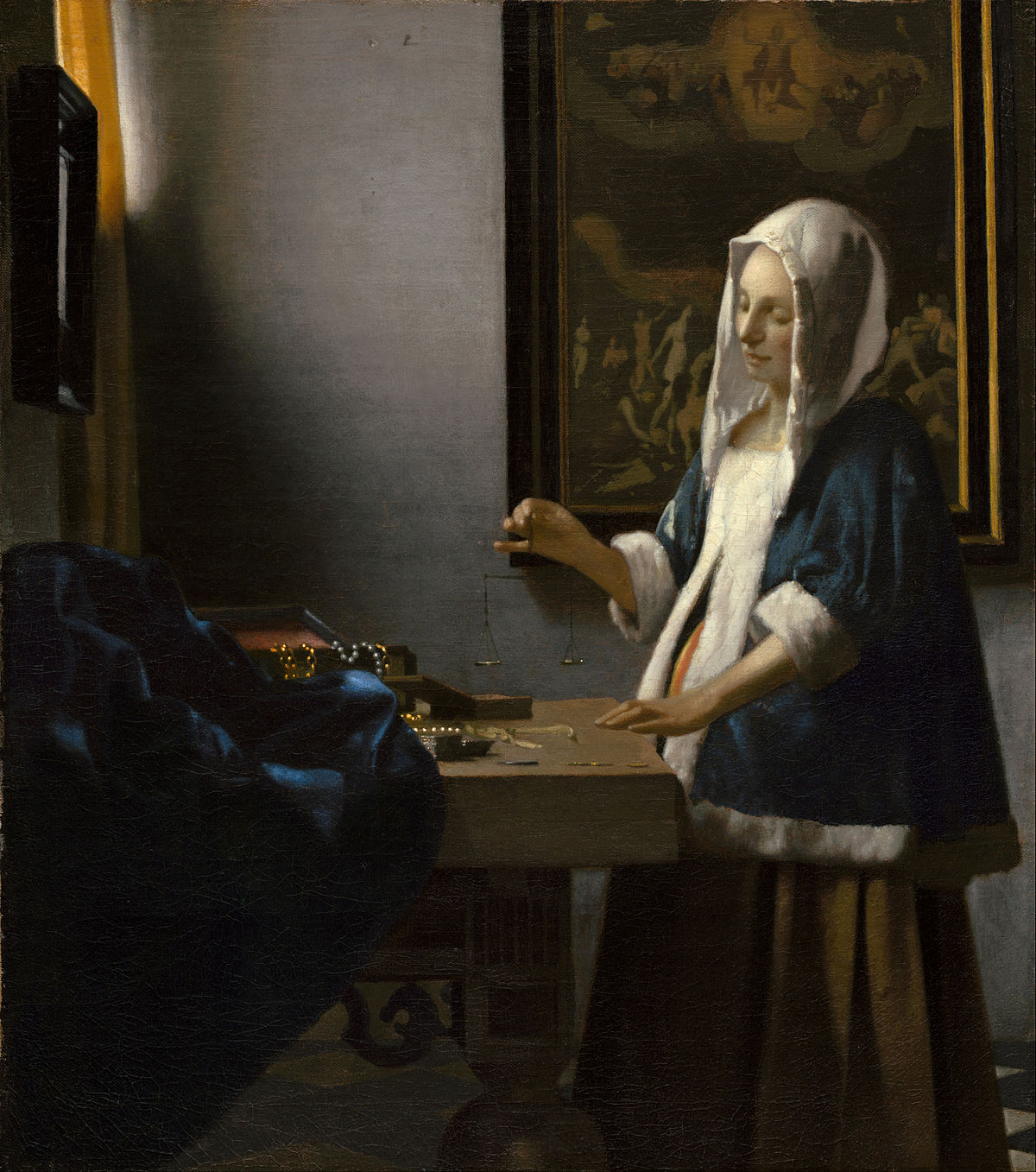
➼ Fruit and Insects
Details
By Rachel Ruysch
c. 1664
Dutch Baroque Art
Made of oil in wood
Found in Uffizi, Florence
Form
Asymmetrical, artful arrangement.
A finely detailed illustration of natural objects in a rural setting.
Content
Not a depiction of actual flowers, but a construct of perfect specimens all in bloom at the same time.
The artist probably used illustrations in botany textbooks as a basis for the painting.
Wheat and grapes juxtaposed: may have been a reference to the Eucharist.
Context
The artist’s father was a professor of anatomy and botany as well as an amateur painter.
The artist produced a number of such still lifes in woodland settings.
Parallels Dutch interest in botany, and the growing of flowers for decorative and medicinal purposes.
Flowers were symbols of wealth and status.
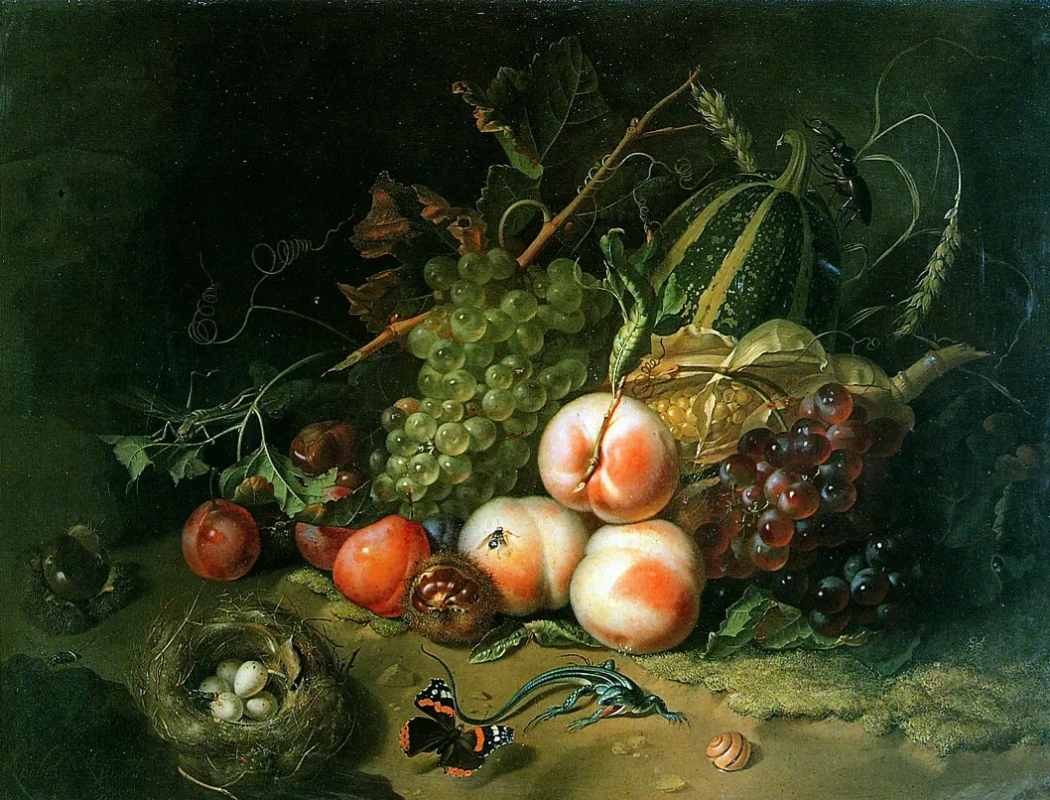
 Knowt
Knowt
